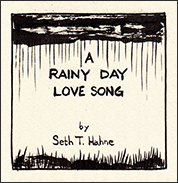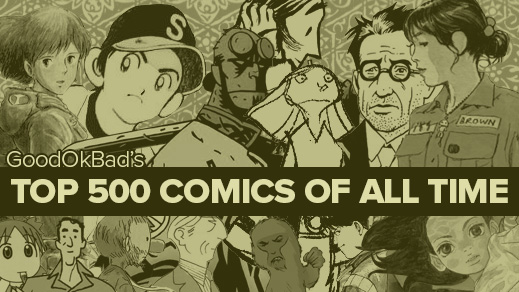

Ranking things is an inherently stupid idea. I mean, if you're going to take it very seriously, it is. By this point we're all aware that these things are subjective and susceptible to biases, personal histories, tastes, and a slight flux in the barometer. There's little objective in art appreciation. In the micro, at least. In the macro, we can with some confidence say things like Jack Kirby was a better artist than Stan Lee or Moby Dick is a better novel than Twilight. But ranking? That's on the micro and when you're ranking The Best of a category that boasts ten thousand options, you're kind of just making it up.
Or to put it more positively, you're making educated guesses. Maybe highly educated guesses, but guesses all the same.
So, some ground rules about this list.
- These are all good books. Some are even great books. But for the most part, there's not going to be much quality difference between books that are 75 places apart. So Book 50 might only be a smidgeon better than Book 125.
- I'm ranking on an amorphous mix of quality in story, quality in writing, quality in art, ideological value, how much I actually like the book, and then some ephemerals like Does this book propel the form in any meaningful way?
- While I have read a lot of graphic novels (I read 400+ volumes per year), I haven't even read all of the canon choices (note: there is no canon, not really). So if you read this list and are pissed off that there's no One! Hundred! Demons! or no Berserk or no Tom King Batman—just know that this is because I haven't read those books.
- I will have forgotten books. Until two days ago, I had forgotten Twin Spica (a personal favourite). There's probably plenty of books I would add but I've just plain forgotten.
- In a week, I'll already regret some of my ordering here. I could edit this list over and over again for years and still not get at something I find completely satisfactory. But I felt it was better to get these recs out there so people could start finding their next favourite comic.
- At the end of the day this is a very personal list and reflects my tastes, knowledge, interests, and experience. Your list, obviously, would look very different. I also highly recommend you put together a ranked list of your top 500 comics. It's fun and exhausting.
Probably the best way for you to approach this list is not as a justification for your own tastes, but instead as a way discover new books that may be just your bag. That's really my intention here, to sing the news of a bunch of great comics for you to check out maybe if they sound like they might be your bag.
And with that, here's the list. I've broken it into 5 pages: 1-100, 101-200, 201-300, 301-500 (for the last 200, I'm merely providing the titles, authors, etc and no or little commentary), and a final page of end notes and explanations to wrap it up [which isn't actually there yet because I still have to put that information together]. By the way, to ground this list in time, it was published on 19 November 2018. (This is so when you run across this list in 2025 and wonder why it doesn't include the best book of 2019, now you know it's because I've been lazy and haven't updated the list.) So then:
1–1011–2021–3031–4041–50
51–6061–7071–8081–9091–100
101-200201-300301-500Afterword
My Best 500 Comics Of All Time*
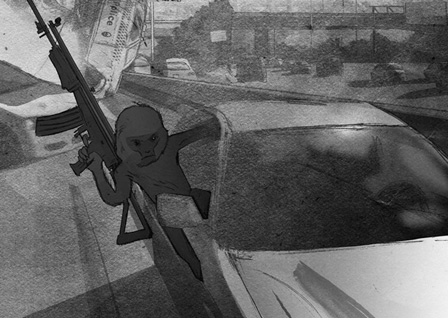
Duncan The Wonder Dog
by Adam Hines
400 pages
Published by AdHouse
ISBN: 0977030490 (Amazon)
Duncan The Wonder Dog is available in print (it's a huge book) and, kind of amazingly, Hines also makes it available for free—amazing because this is my pick for best graphic novel of all time. It's not for everyone, certainly. But it's rich, thick, heartfelt and demands contemplation.
The world presented in Duncan is one that mirrors ours almost exactly—save for the fact that animals can express themselves in the language of humans. This doesn’t change much about the world order. Cattle and pigs are still herded into pens and raised for the slaughter. Dogs and cats still live as pets. And foxes still prey on rabbits. The difference is that now the cows spread rumours about why none of them ever return after leaving for the slaughterhouse while the humans who are slaughtering them lie to them, explaining that the very idea of such murder houses is just silly. Animals (with a few humans) have formed activist groups, some of which have become full-blown terrorist cells. ORAPOST is one such group and it is helmed (for the moment at least) by a golden macaque named Pompeii whose attitude and methodology are as explosive as her name. It’s a world with frayed edges, coming undone even as it seeks to forge itself into something worthwhile.
Duncan's structure is a slow-burn. At first it’s not even clear that in this world animals can talk. And not just talk in that Watership Down sort of way, where animals have voices and can communicate amongst themselves but never to man. In Duncan the animals speak as plainly as you or I do. If you ask a whining dog what’s the matter, she can simply tell you. Once it becomes clear that this is the kind of world that Hines is populating with his characters, a reader still has a hundred or so pages before the books’ protagonists are firmly establish and a plot finally rears its head.
Hines crafts an expansive story with immense value against a tremendous ethical background on broad canvas. This is the story not of the human race but of creaturely existence. And co-existence. And through Hines’ masterful technique Duncan—for all its fantastic setting—essays a profoundly moving, astonishing set of stories, each contributing to the question of co-existence in fresh, exciting ways.
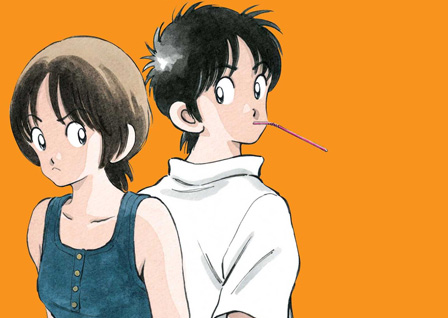
Cross Game
by Mitsuru Adachi (translated by Ralph Yamada and Lillian Olsen, lettered by Jim Keefe and Mark McMurray)
8 vols
Published by Viz
ISBN: 1421537583 (Amazon)
This is the graphic novel I've read more times than any other. It could rightly be called my all-time favourite. (Even if I think that Duncan The Wonder Dog is ultimately the "better" book.) It is so enjoyable that I read all eight volumes every other year at least. Sometimes more often.
Cross Game is, overtly, about baseball. I don't care about baseball. I don't even really like it. I hate spectating sports. And yet, I devour Cross Game because though it is intimately devoted to the majesty of the game (Adachi has done more than five series devoted to baseball). I devour it because it is about so much more than baseball and that "much more" subsumes the baseball part so entirely that I begin to love the baseball part.
When it comes down to a book that I can just settle into after a stressful week or when I'm down or when it's cold out or when there's just been too much rain or when I remember how much love there is in the world, it doesn't come better than Cross Game. Whenever I loan out a copy, I'll flip through the book (as I tend to do whenever I loan out any book) and I'll experience a time skip in which I've accidentally read thirty or forty pages. Sometimes more.
These books are completely, entirely enjoyable. Adachi has had decades to perfect his storytelling craft and this is him playing at the top of his game. Cross Game is fun. Cross Original Aviator Game is funny. Cross Game is sad, is thrilling, is touching, is smart, and is well told. Cross Game is about love and family and friends and loyalty to each—and is the most compulsively readable comic I own. I love it and it always helps me feel like I'm tapping into this thing that is intensely human. It reminds me what it is to love in all of the senses of the word.
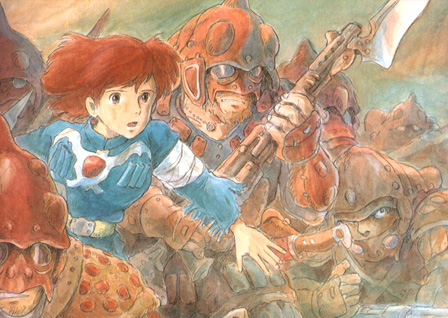
Nausicaä Of The Valley Of Wind
by Hayao Miyazaki (translated by David Lewis and Toren Smith, lettered by Walden Wong)
2 vol omnibus
Published by Viz
ISBN: 1421550644 (Amazon)
This could comfortably sit in probably any critic's Top 10 Comics Of All Time list. Maybe even comfortably in any critic's Top 3?
The story of Nausicaâ is robust. It travels a lot of territory and the narrative terrain shifts constantly. The story at page 100 is different from the story at page 200 is different from the story at page 300. Et cetera. Miyazaki keeps the reader off-balance, constantly renegotiating what his story is actually about. In the hands of a lesser author, Nausicaâ would seem a confused jumble of ideas, an evolving puzzle its own author could not solve. Fortunately, and I think most of the world probably knows this by now, Miyazaki is among the best storytellers of our age. It shows in Nausicaâ. The sureness of his authorial footing in this book is never at doubt. From beginning to end, we are on his ground and it’s a good place to be.
Nausicaâ tells the story of the post-cataclysmic Earth, a millennium after its destruction by the hands of a weaponized robotic army (presumably created by mankind herself). Humanity has barely survived the nuclear fires that tore civilization apart. The earth itself, polluted beyond its ability to heal in a normal manner, has given birth to a terrible new forest. Called the Sea of Corruption, this roiling swath of strange new flora means death to those that it engulfs, for its air is unbreathable. As land becomes more and more scarce due to this growing threat, wars break out and the future of humanity is threatened all the more. In the midst of this, Nausicaâ, a princess of a small outlying tribe, seeks to unravel the mysteries of the Sea of Corruption while negotiating a dangerous path between two warring nations. The princess herself is a mystery to all those she encounters, part chaos, part mercy, and always navigating her own path.
For those familiar with Miyazaki’s films, the art will seem a familiar prototype, an early version of what would become the Ghibli house style for the next thirty years. In tone, Nausicaâ probably closest resembles the sometimes violent action and environmentalism of Princess Mononoke (though those that weary of that message shouldn’t be overly put off by its expression here). The story is long and many panels are more text than imagery as Miyazaki attempts to sensibly exposit his narrative. The tale requires patience and perseverance, but it rewards its pursuers. There are a number of great adventures told through the comics medium, but Nausicaâ is so far—and pretty easily—among the best of show.
This was made into an animated film that is sad and tawdry by comparison. The film was made when the story was 1/4 complete. It sits as a good mid-'80s proof of concept, but it's got nothing on the comic.
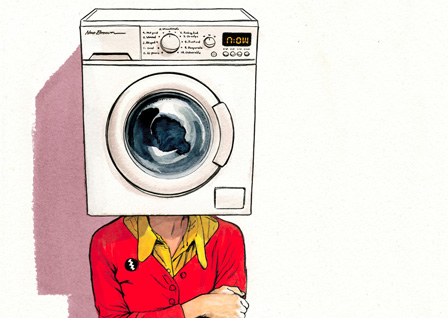
The Nao Of Brown
by Glyn Dillon
208 pages
Published by Self Made Hero
ISBN: 1906838429 (Amazon)
The Nao of Brown is a wonderful collection of visual and literary themes, marked by a compassionate visual sense and a deeply dialogical atmosphere. It’s one of those books in which word and image conspire together in a harmony unusual for comics.
Dillon is not only an impressive illustrator and designer. His art always on every page aids his story, lending voice and colour to his characters’ dialogue—and to Nao’s narration. In a work in which the majority is filled with mundane conversation, Dillon invests his characters with expression, carriage, and posture such that their story would be incomplete if only left with their words. These are real people and they are rendered realistically save for the fact that Dillon captures them in the best possible moment—all in order of course that the reality their story should be validated by their presence.
The art is gorgeous, pencil and watercolour (though these days it can be hard to tell just how much is post-processed in Photoshop—as if it mattered in the end). Dillon couches his work in a rich tapestry of visual metaphor. Rich enough at least that there’s plenty of fodder for those willing to put the work in to interpret him. Visual motifs abound. From the recurring use of the circle to foreign and foreign-esque cartoon characters, everything evokes. The pages bleed with purpose. Even Dillon’s use of colour seems to bear on his meaning. Nao wears red. All the time. Every time. Until the times she doesn’t. The Nao of Brown is such a delight to the eyes that I find myself wishing every book looked like this—despite loving much the more simple work of Chris Ware and Jason. Dillon’s art breathes, it has life. And life is exactly what his story demands.
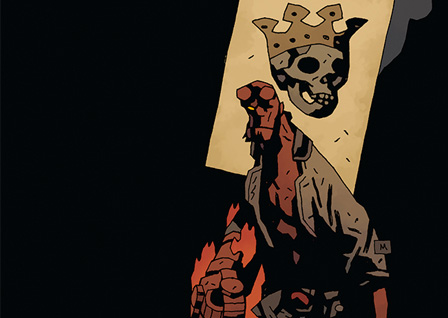
Hellboy
by Mike Mignola (with Duncan Fegrado, coloured by Dave Stewart, lettered by Clem Robins)
14 vols
Published by Dark Horse
ISBN: 1593079109 (Amazon)
Hellboy ended in 2016. And apart from some rare bumps in the road (always due to Mignola's collaboration with another artist or writer), the series has essentially just been the best comics. The series started off in a rough place, with bold beautiful art from Mignola, but also with janky, overheated, silly writing by John Byrne. By the time of the second Hellboy story ("The Wolves Of St August"), Mignola took over the writing and the book became the most amazing thing. And then it got better. And better.
And then, six years ago, Hellboy died. And went to hell. The final two volumes are just him wandering the non-heavenly afterlife and coming to terms with what his tie to destiny is or isn't. It's somber, funny, and bizarre. And gorgeous.
Hellboy (when done by Mignola) has always been a masterclass in comicbooking. His page design, his illustration, his tone balance, his writing. It's all nearly indistinguishable from perfection. Hellboy's concept is ridiculous pulp nonsense: a paranormal investigator who is actually from hell! But Mignola takes that and makes it not feel like pulp but Art and Literature. And as Mignola wraps the book with both a bang and a whimper, the reader will be forgiven for wanting to take it all in again as soon as possible. Sublime work.
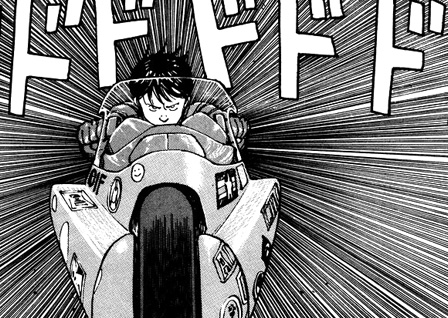
Akira
by Katsuhiro Otomo (translated by Yoko Emezawa w/ Linda M. York, lettered by Michael Higgins, colouring by Steve Oliff)
6 vols
Published by Marvel/Dark Horse/Kodansha
ISBN: 1632364611 (Amazon)
Akira is pretty much just legendary. One of those books that is so good that it ought to sit comfortably in the top half of any reputable Top 20 comics of all time list.
And it's not just one of those books that is lauded and recognized for its place in comics history. Akira is every bit as vibrant and jaw-dropping today as it was in 1989, when I first encountered it. That a book produced in the '80s should 30 years later still feel better and more accomplished than nearly anything in the last ten years is impressive, seeing as how we are essentially living in a golden age where every living artist can do pretty much whatever kind of comic they want.
Akira spawned an awe-striking animated film that basically turned the american sense of what animation could be on its head even though Akira the movie was a piss-poor adaptation of the glories found in Akira the book. (I remember wearing out my Streamline VHS tape back in 9th grade and it's still that dub that echoes through my mind whenever I remember scenes from the movie.)
Akira is about the leader of a teen biker gang that runs the streets of Neo Tokyo, a Tokyo that has arisen from the ashes of a terrible explosion decades earlier. It's about one of that leader's lieutenants who after an accident begins to develop powerful psychic powers. It's about how those unstoppable psychic powers, powers that make him a god, are nothing next to the powers of a kid who's been on ice for decades. It's about a city under military control. It's about politics and religion and annihilation and apocalypse and drugs and revolution and lasers and hovercraft and motorcycles and a guy who really just wants to spend some sexy time with this one girl terrorist.
When Marvel first brought Akira to the US, colourizing it and having Otomo redraw a couple scenes that wouldn't likely fly on American shores (like full frontal of a teen boy, redrawn to show him from behind instead), it was a revelation. If you are picking up Akira today for the first time, it will be a revelation. Last time I reread the series, it was a revelation—the book is so thoroughly a legend, so thoroughly a part of the comics canon, that it's easy to forget just how magnificent it really is.
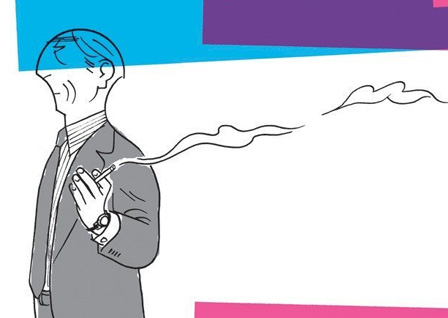
Asterios Polyp
by David Mazzucchelli
344 pages
Published by Pantheon
ISBN: 0307377326 (Amazon)
Kind of like with the writings of Kazuo Ishiguro, reality, perception, and memory play a huge role in Mazzucchelli’s work here.
On top of this is layered the framework of Greek tragedy with specific allusion to the myth of Orpheus (this is pointed out through fistfuls of overt clues, not the least of which is a dream in which Asterios takes the role of Orpheus and his ex-wife Hana embodies Eurydice). We get narrative explanations from a meta-source in the Greek choral tradition. Comparisons to Dionysus and Apollo lead to an evaluation of dualistic systems (and perhaps systems generally) as Asterios gradually must free himself from systemic shackles in order to finally grow up. Of course we suspect if Asterios abandons one aspect he will be destroyed even as Orpheus was for abandoning Dionysus. As well, there are plenty of references to The Odyssey and readers will find this cross-pollination of mythologies only serves to enrich the experience of Asterios’ journey.
The subject matter, by its summary, sounds simple enough but Mazzucchelli throws so much into this piece and exercises such deft control over the page that one can easily drown in the details. The art is very particular. Much is made of Mazzucchelli’s use of colour through the book and, well, with good reason. The colouring itself offers storytelling that is available through no other means. In fact, so occasionally powerful is his use of colour that I worry for colourblind readers, that they might miss out on some of the book’s more sublime moments.
On top of Mazzucchelli’s tight reign over his colour spectrum, there is ample evidence that he maintains the same level of control over his linework and design. Asterios Polyp is a thoroughly designed experience, with every element from script to story to illustration to panel design to colouration to control of whitespace adding voice to the chorus of this performance. The battle between geometric and organic shapes gives readers (who may not be familiar with all the names and ideas Asterios or his ghostly narrator references) a hook on which to hang their interpreter’s hat. One’s experience of Asterios Polyp will no doubt be more enriched by a working knowledge of architectural history, familiarity with Greek mythology and Homeric tradition, and a smackerel of understanding of postmodern sculpture—but Mazzucchelli’s conveyance of story through his visual sense means that even those with Asterios-sized gaps in their education can still get in there and have some deeper sense of what’s going on.
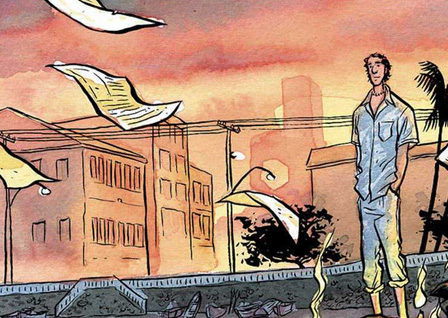
Daytripper
by Gabriel Bá and Fabio Moon (coloured by Dave Stewart, lettered by Sean Konot)
256 pages
Published by Vertigo
ISBN: 1401229697 (Amazon)
Brás is occupied as the writer of obituaries and it is through this peculiar vantage that his own story unfolds. It is established early on that death is a part of life—perhaps largely so that we might get that out of the way and begin exploring what that precipitates in a meaningful way. Through the book’s constant return to the obituary, we are able to gradually piece together a philosophy of living, a valuation of lifespans. Moon and Bá present a carefully constructed yet simple meditation on what it means to be us and how life, death, and society conspire to bring meaning to the purposes we may invent for ourselves.
In trying to pin down the crowning achievement among all Daytripper’s perfections, I find myself struggling. There are so many wonderful things about this work that to attempt to elevate one above the others seems juvenile, a task for children who aren’t really concerned with absorbing the book for what it is. So then, I guess, let’s speak broadly.
First, the art that fills and wraps the book is just wonderful. Through the pen and the brush, Fabio Moon crafts a world that is wholly believable, one that holds as much life as the characters that inhabit it. The set designs are so varied and detailed and appropriate that it becomes easy for the reader to just pass by never considering the time and thought that went into planning these breathing environments. I would recommend all readers reserve an hour after finishing the book to just flip through the pages and take in the world of Daytripper without the press of narrative or dialogue or exposition or monologue hurrying attention on to the question of What Comes Next.
The degree of life invested in these characters and—specifically—into our protagonist is something special when one considers that we are only given ten short chapters with which to acquaint ourselves with those who comprise the world through which our protagonist explores his own life, purpose, and meaning. Well before the final page, he feels like a character fully revealed—as if, were the creators to free him from the shackles of the page, an attentive reader might be able to predict the course of his life. I feel privileged to have been allowed to take part in his life while he discovers its directions, purpose, and passions.

Building Stories
by Chris Ware
260 pages
Published by Pantheon
ISBN: 0375424334 (Amazon)
It’s entirely possible/likely that no one will have experienced the same story as I did when I read it or you will when you read it. The total possible number of different ways to approach Building Stories is 87,178,219,200 (or more than 87 billion, or 12 times the population of the earth).
Building Stories is a box. A box containing fourteen individual pieces of comics media of different sizes and dimensions. Fourteen stories, some hardbound, some in the form of pamphlets, some the size of newspapers (for those who remember newspapers). One was an 11"x16" folding screen, like a boardgame board. Another two were single pieces of quad-folded paper (like travel brochures), about as tall as the width of a business card but maybe seven inches in length. There is no prescribed, proscribed, or recommended order for reading these fourteen stories.
Ware’s protagonist (so much as there is one) is more like a full-orbed person and experiences both highs and lows. As well, her thought-life is robust. While she definitely does wallow occasionally in self-pity and a panoply of woe-is-me scenarios, she’s also thoughtful about social issues and the ethics of trivial actions. There’s even fleeting interest in questions of philosophy and theology. She is a woman built of hopes, recriminations, desires, disgusts, fears, joys, and a waxing and waning of drive. Much like any of us.
While Building Stories may not function so much as a traditional novel—offering a common Western narrative structure of beginning, middle, end—it does what it does very well. There is no overall build of tension, no climax, no denouement—but there was also never any pretension to such things. Beyond the impossibility of discovering The Correct Order in which to read Ware’s creation, his intention is less about unveiling a plot as it is about discovering a life lived. This is the life of the Woman, and by the end of it you will know her as well as you know many of your friends. She is undressed, not for your approval so much as for your empathy. This could be the closest many of us will come to walking in another’s shoes.

Berlin
by Jason Lutes
580 pages
Published by Drawn & Quarterly
ISBN: 1770463267 (Amazon)
Every now and again, a comic comes out that assures me that the medium can tell certain kinds of stories in a way that no other medium can touch. Every now and again, a comic comes out that despite its natural humility asserts itself as a model to which the medium should aspire. Every now and again, a comic comes out that just flat-out knocks me off my feet and makes me think that everything is going to be alright after all.
It’s not that Berlin presents such a rosie view of the panoply of human history. It doesn’t. It’s not that Berlin offers a solution to the din of political strife that will always wrack the tired bones of human society. It doesn’t. And it’s not even that Berlin allows true love to conquer even the dankest moments of our human despair. It can’t.
What Lutes’ book does, however, is demonstrate that creative geniuses still stalk the earth. His storytelling is virtuosic. And in addition to his mastery of the comic medium, Lutes proves himself an excellent student of the human state, capturing intricately the poisons that infects us all. Sure he depicts flawlessly the poor, huddled masses as they struggle to stave off starvation and fight for a political hope that will surely disappoint (as political hopes are wont to do), but further, he delivers too on the poisons that infect even human joy and celebration. We are given witness to ecstasy and abandon, but simultaneously, we also are allowed to see the darkness that threatens from the horizon, that in some sense has already crept into the lives of the happy.
And Lutes does this in such a way that he doesn’t come off as depressing so much as he does real. There is a veracity to his work that I cannot help but admire. As far as story direction, I didn’t like some of his choices for some of his characters. But they were always real choices. And I respect the story for it. And they set up well the story to come.
1–1011–2021–3031–4041–50
51–6061–7071–8081–9091–100
101-200201-300301-500Afterword
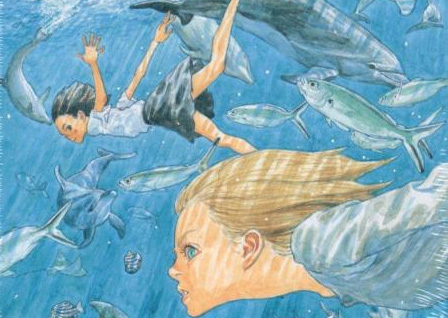
Children Of The Sea
by Daisuke Igarashi (translated by JN Productions, lettered by Jose Macasocol)
5 vols
Published by Viz
ISBN: 1421529149 (Amazon)
Here's something: I feel in greater connection to nature when reading Children Of The Sea than when actually out in nature itself.
Igarashi's work is specially known for his illustrations and treatment of the natural world. He is lushly reverent but his style is atypical, meaning it's difficult for a lot of readers to see the allure. He invokes wonder and mystery and makes that world holy.
One of the things I thought about last time I reread the short series was that as an artist par excellence, his every choice of line is intentional. He succinctly takes the chaos and scattered beauty of nature and concatenates it into a specific image, crafting a kind of paragon nature. This is why I may feel more connection to the natural in reading his works than when in nature itself. He conveys the grandeur and the majesty without the distraction of chaos.
(Or more accurately, without the distracting appearance of chaos. Think of your own hypothetical photos of Yosemite vs those taken by Ansel Adams. In reality we know that everything is governed by a towering compilation of causes and effects, but it's all just too complicated, so we call it chaos to make ourselves feel better, taking madness and submitting it under the thumb of taxonomy.)
I wanted to mention Children Of The Sea in this post simply because the books mean so much to me. Every time I read them, they impresses upon me more and more a sense of divine glory. I may see creation's majesty more in Igarashi's books than by any other venue. I'm averse to speaking in these terms because they are always either ineffectual at communicating or are baldly hyperbolic, but I find in Children Of The Sea this cascade of Sacred moments that I cannot get away from.
To further dive into terrible, deeply exaggerated cliche, it is in these five volumes that I find closest experience to the idea of Touching The Face Of God. In reading Igarashi, I feel as though I am Moses (for the literary or religious among you), hidden in the cleft, witnessing not God himself but instead the contrail of God's glory. Nothing else brings me as close.
And the great tragedy is that the book is so unique in its story and art that I rarely find myself able to recommend it because I know how rarely it appeals to anyone. And what is worse than saying that you beheld God's awestriking majesty, pointing someone else to it, and them having seen the exact same thing as you, saying, "Huh, he's not a very good artist, is he?"
In any case, these first images are a six-page sequence of the beginning of a rainfall and its transition to clear skies. I follow this with some scattered images of sea life.
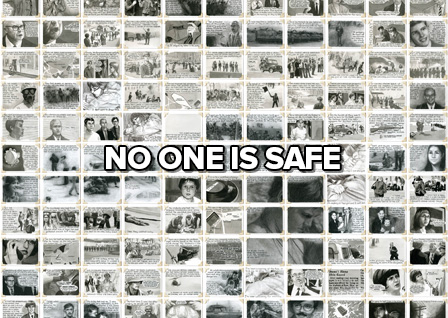
No One Is Safe
by Katherine Wirick
1 page
Self-published
Acquire it in digital here
No One Is Safe is an emotional work building its pathos on several foundations. It doesn’t as violently tear at one’s heart as, say, Twin Spica does, but in being modeled on real life, its agonies seem more present—even if of a more quiet variety. Wirick investigates the Kent State shooting, her father’s relationship to the Kent State shooting, and her own relationship to an ailing father. Her investment seems total. There are moments when the project looks as if it may be too much for her to bear. The reader knows this because as an interruptive narrator, she tells us as much; but these parentheticals, these hiccoughs, are not missteps in her narrative—indeed, the four or five panels in which she breaks from script and invites us into her experience of pain are some of the work’s defining moments. Not only are they abrupt breaks in the narrative chain, but they visually take a step away from the project’s principal conceit.
Wirick’s tremendous five-by-five-foot grid is composed of over 150 separate pieces of paper. They are painted on, drawn on, in such a way as to resemble the photographs we may remember from the ’60s—black and white with a quarter-inch of white border. These are fastened to her canvas with those little adhesive corner mounts that were common in all the best photo albums when I was four. Wirick’s three stories unfold and untangle and retangle across these “photographs” in a manner that is at once both practiced-and-careful and comfortably fluid. She appears in this work a confident author whose work deserves whatever attention you will afford it. And then she breaks her rules spectacularly.
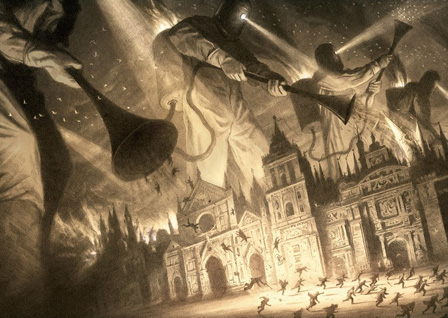
The Arrival
by Shaun Tan
128 pages
Published by Arthur A. Levine
ISBN: 0439895294 (Amazon)
The immigrant experience isn’t the kind of monolithic thing that can actually be described using definite articles like “the.” It’s not as if every immigrant’s entry into a new culture follows a singular, well-trod path. The circumstances of each individual’s introduction to and incorporation into a new national heritage are as diverse and variegated as the expatriated themselves. Still, there are certain commonalities that often crop up in every new experience — every immigrating instance — whether moving from one nation to another or simply moving from L.A. to Seattle. Or taking a new job or attending a new school.
What Shaun Tan does in The Arrival — and does marvelously — is propose a cross-section of these immigrant experiences in such a way that even the reader who has never breached his own comfort zone might empathize. Tan offers to involve the curious into an experience that is confusing, disorienting, and alienating. That is, Tan wants to make us all immigrants for the space of his book. And he succeeds wildly.
The Arrival follows the experiences of a man who leaves his wife and daughter behind in order to pave a new path and new fortune for them in a land brimming with possibilities. He’s abandoned a country beset by grave ills but his road through his new home is anything but smooth. He does not speak the language, does not recognize the customs, and misses his family terribly. He is a man lost and Tan pulls the reader into his experience first by making the book silent, cutting all dialogue or narration. Then, mounting on this already sturdy platform of alienation, Tan introduces a world filled with bizarre contraptions, foods, sciences, and rituals — and then asks us shuffle along with his protagonist. It’s wondrous and frustrating all at once. We feel for the poor immigrant because if it’s hard on us (outside the book with no investment greater than personal interest), then it’s exponentially more difficult for him, with his wife and child and their survival on the line.
Silent comics have long struck me as a gimmick. None of the wordless comics I'd read seemed to use silence to any narratively purposeful end and in none of those cases was the story magnified by its lack of words. The Arrival is the first work I’ve read in which silence is essential to the experience. Tan uses the absence of dialogue, narrative balloons, or sound effects to propel his story and any verbal addition would doubtlessly hinder his purpose.
The Arrival is one of the very best comics experiences I’ve ever encountered and is well worth your time.

Alpha: Directives
by Jens Harder (translated by Nora Goldberg)
362 pages
Published by Knockabout/Fanfare
ISBN: 0861662458 (Amazon)
Alpha is a weird book. Or maybe not weird so much as maddeningly genius. It's part one of a proposed trilogy. Beta has already been released in German but Gamma remains only on the Potential horizon. It's too ambitious. Maybe it will never be completed but maybe it will. Fortunately, Alpha stands well on it's own.
Alpha presents the history of the earth from Big Bang through the cenozioc. Beta focuses on the rise of humanity from cenozoic to the present day. Gamma will tell the history of the world from today til the end of the universe. Where these books are unique is in the methodology.
Harder tells the story of the world through borrowed images. He came up with nothing in the book on his own. He drew everything, sure, but it's all redrawings of other things—from scientific illustrations, to illuminated manuscripts, to ancient maps, to sculptures, to comics and other pop cultural ephemera. You'll see things in panels in the pages I post that you recognize. Maybe it's Tintin, maybe it's Godzilla, maybe it's Goya's Saturn. The book, by its method, holistically draws from the whole of human history and experience and belief to make the story of creation our story.
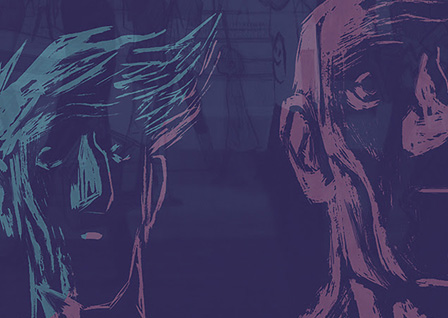
Equinoxes
by Cyril Pedrosa (translated by Joe Johnson, lettered by Ortho)
336 pages
Published by NBM
ISBN: 1681120801 (Amazon)
Equinoxes juggles the lives of about ten characters in France across the four seasons and ending in Summer 2002. Many of these lives are only tacitly related, interacting only glancingly at perhaps a single point in their histories. There are connecting threads, of course. A prospective airport and the mild political unrest it causes, a minister of the environment, a painting in a cave, a painting on a canvas, a handful of songs, and (most presently) a young woman with a camera. One of the principle characters remains obscure throughout but her fascination with an old camera gives the reader a window into many souls—every time she takes a person's picture the comics form is interrupted by the intrusion of a prose investigation of the captured individual, as if we're getting a sense of that person's conscious and subconscious self in the precise moment of the camera's click.
Apart from this particular conceit, the book also develops visually through the four seasons, with each being marked by a distinct alteration to the style of illustration. Either idiosyncrasy would be a fascinating aspect for Equinoxes to engage, but when taken together along with the superlative writing and thoughtfulness to the book, it becomes clear that Pedrosa's book is something special—and why it was my choice for best book of the 2016.
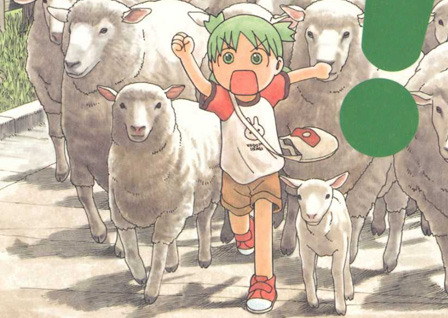
Yotsuba&!
by Kiyohiko Azuma (translated by Javier Lopez/Stephen Paul, lettered by Scott Howard?/Terri Delgado/Abigail Blackman)
13+ vols
Published by ADV/Yen Press
ISBN: 0316073873 (Amazon)
Yotsuba&! is a source of deep magic for me. And, I suspect, for a great number of others as well. Kiyohiko Azuma’s series is an unexpected pleasure. Even if one approaches the work with the knowledge that Yotsuba&! bubbles forth as a fountain of joyfulness, this little girl’s nature and adventures will still surprise in how purely they deliver one into this momentary Other Place.
Four-year-old Yotsuba’s sense of wonder in the way she approaches an environment with which she apparently has had no experience is astonishing in its guilelessness. Yotsuba brims with enthusiasm and the pleasure with which she takes on each new experience leaves us breathless as that enthusiasm spreads. Her father is consistently amused by her naïveté and her neighbours are never certain what exactly to make of her. And yet, she really does inspire affection in everyone she encounters.
My descriptions can only serve as a diminishment to what pleasures are actually found in the book. I am entirely out of my depth to sound out Yotsuba&!'s charms, but perhaps we should just leave it at this: whenever a new volume arrives in the mail, I curl up comfortably with my wife, finding the best lighting possible under such snuggly conditions, and I read each chapter to her aloud, trying to muster in my own voice the clear enthusiasm in Yotsuba’s own.
And then we both smile a lot.
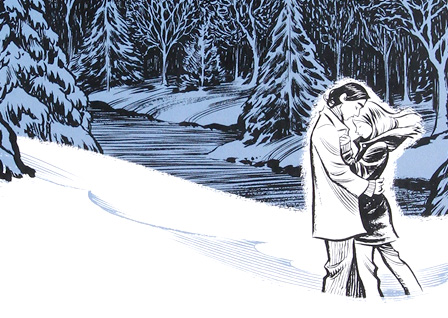
Blankets
by Craig Thompson
592 pages
Published by Top Shelf/Drawn & Quarterly
ISBN: 177046218X (Amazon)
There are any number of reasons that Thompson’s work should be lauded. His art is gorgeous and his brushline expressive. He treats personal topics with a sense of both whimsy and honesty. He writes true experiences, even when they’re fictional. And as great as all those things are, there is one idea that stands out in his work that I’ve yet to see another creator tackle (let alone master) as Thompson has done.
His sense of the sacred and his ability to convey it in ink is breathtaking. He offers his readers these holy moments, these frozen, fluid, organic treasures. These sacramentals. Whether he intends to lead the reader into a religious experience or not, his work really is very spiritual. As spiritual as an atheistic holy experience can actually be at any rate. There may be moments in Miyazaki that approach the wonder of the sanctuaries that Thompson builds in Blankets. It’s for this reason (among others) that Thompson’s second book remains one of my favourites, even years after having first encountered it.
Semi-autobiographically chronicling (via chrono-thematic structuring) his early life—from his establishment in faith and his discovery of love to his abandonment of that love and his subsequent abandonment of faith—Thompson plays honestly at all times with his story elements, thereby lending his tale an uncanny credibility. And while flashbacks and tangents proliferate, the overarching chiastic structure verifies the reader’s intuition that Thompson knows well where he is headed and is going to take you there whether you like it or not.
This book is a masterpiece of form, symbol, and structure. Tokens bend and writhe and carry narrative significance throughout. Thompson’s art here is fluid and serves well to establish the variety of moods described in his several vignettes. Blankets is an evocative work that should not be missed by any who would appreciate a serious, heartfelt, and magical telling of the tragedy and wonder of what it means to come of age.

Sunny
by Taiyo Matsumoto and Saho Tono (translated by Michael Arias, lettered by Deron Bennett)
6 vols
Published by Viz
ISBN: 1421555255 (Amazon)
Sunny is about a collection of kids interred at Star Kids Home in the late '70s. Some of these kids are straight orphans, some have parents who want them but can't support them, some have parents who just can't be bothered. The series is amazing and one of the best things going.
Matsumoto's evolving series of pericopes peeking in on the lives of the residents of a late '70s foster home is at once vital, brooding, joyous, grim, and heartfelt. It may be the perfect encapsulation of the human condition. And amazingly, the series improbably improves with each volume. In 2015's volume 5, I feel more and more the need for the series' finale in volume 6 to provide some sort of "20 Years Later" epilogue—if only for how crisply and seamlessly these characters have been brought to life for me. My heart pulls for these kids—and for the adults who mind them. With every victory I soar and with every defeat I sorrow. I can think of no better compliment than to say that Sunny is one of the most honest, affecting works I've encountered. I love that this exists and I love the care with which Viz has packaged it.
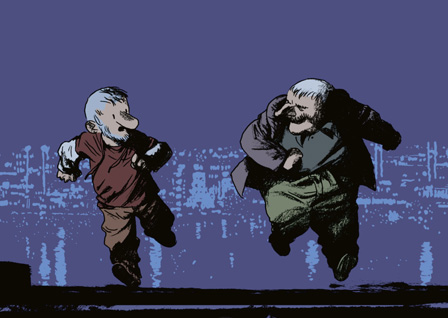
Ordinary Victories
by Manu Larcenet (coloured by Patrice Larcenet, translated by Joe Johnson, lettered by Ortho)
2 vols
Published by NBM
ISBN: 1561634239 (Amazon)
Ordinary victories is an extraordinary book. It's rather simple on the face of it (a young photographer with panic attacks struggles to socially adapt to life that isn't on his terms) and by setting and dialogue becomes something great. While dealing with Marco's neuroses and the will he/won't he of whether he'll have a successful relationship (with his parents, with his brother, with his girlfriend, with his neighbours), most interesting to me was the book's exploration of the question of separation of art and artist when one or the other sucks. Who deserves our scorn? And how scorched earth should we be in the application of that scorn? How much do our convictions matter? How much do we martyr ourselves?
As the moral detritus of so many artistic heroes finally begins washing up and we see more incisively how terrible some of our most creative minds truly are or were, these questions will be more and more central to the average person's consumption of art.
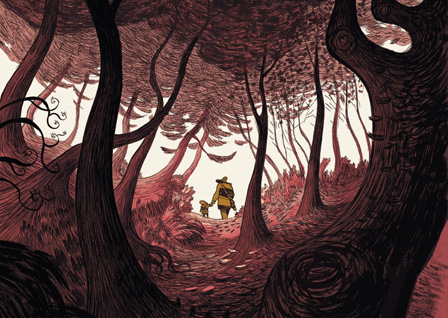
Three Shadows
by Cyril Pedrosa (translated by Edward Gauvin)
272 pages
Published by First Second
ISBN: 159643239X (Amazon)
Three Shadows, for all its heartbreak, really is a wonderful work. Pedrosa’s art is dynamic and assured, balancing a deep naturalism with necessary storytelling chops. I want to see more of his work and I want to see it now. His visual sense more than compensates for how little dialogue wanders through his book. Certainly Pedrosa uses words, but more often than not, he simply uses his pagework to bring texture and life to his story about death.
Any work about such a darkly emotional topic will find itself hounded by one great threat: the danger of becoming a cheap, sentimentalist ploy. A full ninety-three percent of movies about dogs fall into this trap. Easy manipulation. Contrived heartbreak. Formulaic beats. As Hollywood shows us at least yearly, hammering on heartstrings to get a reaction and jerk some tears is child’s play for even incompetent writers. Pedrosa could have gone this route and let his artwork trick us into thinking we were reading something great and whelming. He, fortunately, is better than that.
Pedrosa’s book balances between whimsical, fantasy elements and the darkness of real-world tragedies, delivering something closer to a meditation on impending loss than a critique of how one might deal with such an inherently counter-rational experience. Despite its subject matter, Three Shadows never threatens to be more than one can take. If anything, its lessons are delivered gently and with deep empathy.
1–1011–2021–3031–4041–50
51–6061–7071–8081–9091–100
101-200201-300301-500Afterword
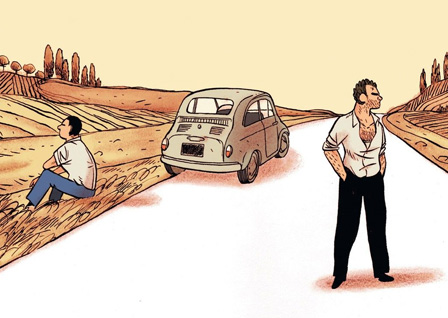
Come Prima
by Alfred (translated by Studio Charon)
224 pages
Published by Delacourt
Buy digital: (Kindle/Comixology)
Come Prima is a fairly simple story (in the, say, '60s this guy with an urn goes to pick up his estranged brother and take him back from France to Italy in a beat-up old car and maybe they'll talk it out on the way), but the way it makes use of the form is superlative. And not superlative in that possibly pretentious sort of way a lot of would-be masters engage. This stuff is natural, organic, perfectly at home with the lazy sort of human chaos that inhabits the story being told.
Dialogically this work is grounded and earthy, but visually Alfred gives us raw lyricism and beauty. I fell in love with this book early on. Highest recommendation. But only avialable in English on Comixology.
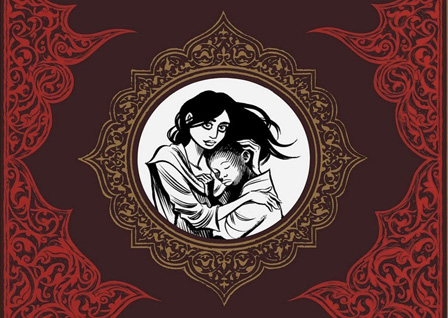
Habibi
by Craig Thompson
672 pages
Published by Pantheon
ISBN: 0375424148 (Amazon)
Through a work criticized both for its Orientalism and its skirting of misogyny, Thompson balances several themes throughout Habibi's unfolded history of two runaway slaves, but perhaps chief among these is an exploration of love, of true love—and how it can exist, flourish, and grow even (and sometimes especially) in the absence of sexual fulfillment. Some authors focus on women as pure objects, as receptacles for sexuality to the exclusion of their ability to exist as full-orbed human persons with dreams, hopes, loves, or even (for the most part) personalities; Thompson, on the other hand, uses the objectification of his characters to craft them into noble persons deserving of dignity, of hope, of love. It's a fine line and your mileage may vary on how successful you think Thompson is at walking it.
Habibi is a major work in comics literature and Thompson’s first since the nearly-six-hundred-page Blankets. Comparisons will be obvious. Both works traffic deeply in religious language and colour their texts in displays of sacred ferocity. Both explore the boundaries and need for love and human contact. Both play with non-linearity in storytelling, skipping back and forth and only revealing the past in time to illuminate the future. These two creations are very much the work of the same author and it’s a joy to see his voice maturing.
In both tone and scope, Habibi is an entirely more ambitious work. We see Thompson redressing things that were focal points in Blankets. In the former book, Raina is depicted in such sacred light by Thompson that she becomes the ultimate example of female sexual objectification—all with the best intentions of course, but when young Craig deifies her, he makes her into little better than a graven image. In Habibi, however, when Dodola is depicted nude (which is often), she is wholly human. This is a triumph of Thompson’s technique, for in the midst of the narrative she is being wholly objectified, yet these instances serve only to drive home her humanity. For the majority of those within Habibi's narrative landscape, Dodola exists much as many men's ideal woman—she is merely a receptacle for their sexual advances. Thompson, however, prevents the reader from seeing her in this way by refusing to give her the visual lyricism he bestowed upon Raina. Both are sacred and both are holy, but the one is made so by her sexuality while the other is made so by her personhood. It’s a difficult line to draw and that Thompson illustrates it so well ably demonstrates why he is one of the leading auteurs in the medium.
Habibi is a book marked by rape, slavery, castration, forced marriages, the murder of children, harems, and love. While in its murk and depths, it may not seem possible that the last of these—love—should so completely over-power all else, this is the case. Love is not always victorious, but it is always glorious. The love of these two for each other is simultaneously heart-rending and heart-warming.
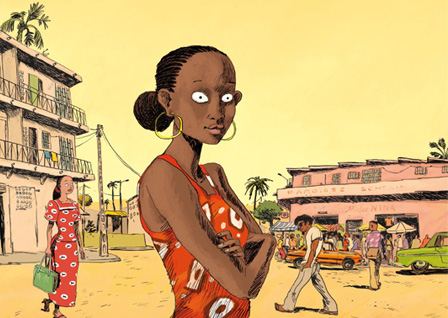
Aya: Life In Yop City
by Marguerite Abouet and Clement Oubrerie (translated by Helge Dascher)
2 vols
Published by Drawn & Quarterly
ISBN: 1770460829 (Amazon)
Aya is one of the coolest things. Taking place in Yopougon (colloquially known as Yop City), a suburb of Abidjan in Côte d’Ivoire, tells more than the story of Aya and her friends, acquaintances, rivals, and relations. On top of that, it unveils a culture unique to a 20 year period and now lost to that era in history.
Between 1960 and 1980, Côte d’Ivoire thrived economically in a way that other newly independent African nations did not. Rather than drive out European populations and influences, those ties were welcomed and strengthened—and the wealth and assistance of France helped the economy boom in particular ways.
Aya exists in the US as two volumes, each containing three of the original graphic albums in which the series originally appeared. Aya is about 20 years old, single, beautiful, wise, naive, and soberminded. This story features Aya, yes—but they also tell the stories of Bintou and Adjoua and Hervé and Moussa and Félicité and Mamadou and Innocent and Gregoire and their families and more. It's a multi-multi-threaded narrative that's rambunctious and cacophonic and really is a blast to read.
The book is filled with people making bad but very human decisions, the kinds you or I make and have made regularly through our lives. It's also filled with proverbs. One of the idiosyncracies of life in Cote d'Ivoire is that every is constantly using old proverbs to make points, comfort the abused, and perpetrate savage burns. And everybody nods in understanding as if the speaker just QEDed the whole thing and shut it down. (And it's very amusing when one of the cast goes to France and does the same thing and these poor French people have no idea what's going on.)
While the storylines of Aya can get pretty serious (a guy basically selling his daughter into marriage, coming out of the closet in a culture where that would be dangerous, fake faith healers, rape and sexual assault, adultery, adultery, and more adultery, etc) the wit and barbs and lunacy keep the spirit pretty light-hearted.
One last thing I love about this series is that it doesn't preach or go in for didacticism. It 1) knows that people are people and will do good and bad things, often on the turn of a dime, and 2) presumes the reader intelligent enough to draw their own conclusions. So, for example, when Bintou comments on the rapist's poor looks wonders what gives the him the right to rape so many girls and then comments that "handsome helps," citing a girl who was raped by a cousin and made the best of it, Aya's response of "That's terrible!" is more focused on Bintou (who runs an advice/counseling business) betraying a confidence than on the woman's opinions about rapists (and we already know that Aya doesn't agree with her). It's just one example of hundreds in the book of normal people holding wonky opinions, just like in real life. In a period where a lot of our fiction reads as pedagogy, it's kind of refreshing to run into something that doesn't pull a GI Joe where "knowing is half the battle."
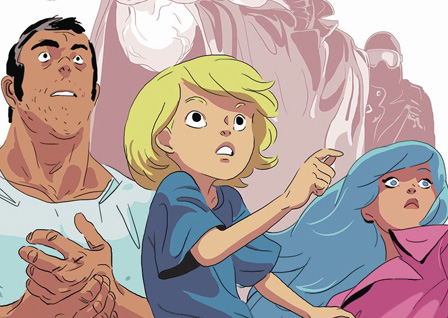
Lastman
by Balak, Michael Sanlaville, and Bastien Vives (translated by Alexis Siegel)
12 vols (only 6 translated into English)
Published by First Second
ISBN: 1626720460 (Amazon)
Last Man is pretty easily one the most exciting series published in the last decade. Beyond being lithely and gorgeously illustrated by Sanlaville and Vivès (Vivès did A Taste Of Chlorine, which I mentioned a few posts back), the story is pulse-poundingly exciting. What begins as a magic fighting tournament in a rather fantasy realm turns into a cross-dimensional adventure when a theft speeds the recently arrived outsider Richard Aldana out of town in a hurry. Young Adrian and his mother give chase and things get out of hand real fast.
And the result is compulsively readable.
The artists portray so much elegance of motion that even heavy, stomping, oxen men move with a kind of liquid energy. Certainly more like a crashing wave than something more gentle, but still. More lithe figures like Adrian exhibit the same sense of weightlessness as the dancers in Vivès earlier work, Polina. The backgrounds, too, are skillfully devised with all manner of unexpected detail. A dragon here, a crowd reaction there. Altogether lovely.
But even better than that—and if you can imagine for a minute the essentiality of fluid combat choreography for this kind of story and then consider that this is better than that—the illustrators hold utter mastery of the characters’ expressions. Their faces are simple but convey a wealth of intents and meanings. Child protagonist Adrian shifts from guileless to guarded to curious to excited to determined to overjoyed, and the purpose behind his countenance is never in doubt. Richard Aldana also modulates between a host of feelings and moods and interests. There is, at all times, the overt story being told through dialogue and action, but simultaneously there is another story told across the faces of this book’s participants, a narrative born in looks and in eyes and in mouths and in shoulders and in the space of physical proximity, one character from another. This is a rich tapestry and this trio of creators demonstrates mastery of all the elements of their stage.
A valid question right now for the US reader is Is it worth it to jump onto a series that publication woes have placed in indefinite limbo? The series is 12 volumes long but it may be that in the US we will only ever get translations of the first 6 volumes. I'd say a guarded, Yes, that it's worth it. Even though vol 6 does end on a pretty cataclysmic cliffhanger, it also wraps up pretty decisively the first major arc of the series and in that sense feels mostly complete. It's not a great feeling to be left hanging with only 50% of the series but that 50% is so well done (despite occasional missteps) that I'd happily recommend the series to any adventure-lovers with the caveat that they know going in that they're reading an incomplete work. [Really, what I'd love is for entire series to be published in four oversized omnibus editions like the Hellboy Library Editions, to give the series its due.]
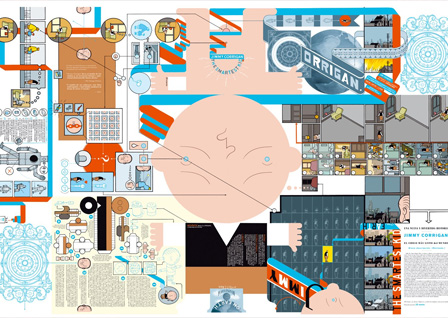
Jimmy Corrigan: The Smartest Kid On Earth
by Chris Ware
380 pages
Published by Pantheon
ISBN: 0375404538 (Amazon)
I don't often talk about Jimmy Corrigan because it's pretty thoroughly enshrined in most versions of the comics canon floating around out there (note: there is no canon). Still, it's one of those books that's highly regarded but not nearly so accessible as Watchmen (yay! superheroes!), Maus (dang! Holocaust), Persepolis (yay! little girl rising up against a repressive regime and not dying!), the usual answers to the question: What should I get for my mom/dad/boyfriend/wife/etc to prove the value of the medium? (I mean, unless you're just gonna go with super-popular0-but-for-adults-because-boobs-and-eff-words, i.e. BKV.)
Jimmy Corrigan would probably play well with a lot of serious grown-up types except for the fact that 1) for the neophyte comics reader, Ware can be friggen impenetrable, and 2) Jimmy Corrigan is, for all it's imagination and flights of fancy, a sad sack of mopey living to read about. It's not, for those reasons, super appealing.
So I'm going to recommend it to you. For a couple reasons.
1) It's formally astonishing. People marvel (and rightly) at how intricately Alan Moore plans and executes his pages in Watchmen—and for sure, that's Watchmen's strongest point. Moore is diabolically exacting. Any halfway worthwhile annotation of the series will unveil that for you. But to me, compared to Ware, it feels like Moore is putting together a 250-piece puzzles of the United States while Ware's just laid the final piece in a 2000 piece jigsaw of the colour red. Watchmen impresses me but Jimmy Corrigan blows my mind. I don't know how he does it. He's so intricate, so exacting, so methodical. (And ironically and sensibly, this magnificence is a put-off for some, rendering his work sterile and over-produced.)
2) He outlines pretty handily a particular kind of person. And depending on who you are, who you know, and your life experiences, this may be revelationary or shrug-worthy. Personally, I don't know anyone who is remotely like Jimmy. Maybe you do. Maybe you know a lot of them. But for those of us who don't, Jimmy is a rigourous peek into a way of living, of thinking, of interacting that we might not otherwise be able to grok. It's unclear exactly how much of Jimmy is autobiographically considered, but from Monograph, it seems like despite whatever similarities exist, Jimmy really is his own persona. And one that the reader well inhabits by story's end.
3) Ware is not only telling the story of Jimmy. He's not only telling the story of five generations of Corrigan men. He's telling a story of Chicago. And when the book takes an extended holiday into the past, Jimmy's story is made so much richer for the excursion. When Brubaker zips back in time in Fatale, it's a neat trick and we see some fun stories, but ultimately it doesn't really matter and the story would be as worthwhile without the flashback. In Jimmy Corrigan, the reverse timeskip is essential. The book would be a hollow shell without it. (Haha, some will argue it's a hollow shell anyway.)
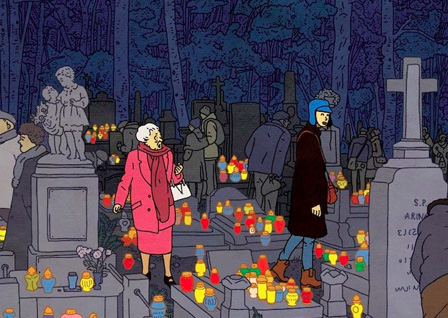
The Property
by Rutu Modan (translated by Jessica Cohen)
168 pages
Published by Drawn & Quasrterly
ISBN: 1770461159 (Amazon)
[Note: If you're looking for a serious literary-fiction graphic novel for a grown-up (say, your mom) to prove the value of the medium, this is probably a good starting point for you (her).]
Ruto Modan’s The Property, for all the many things it is, most interested me in its exploration of both of Linklater's earlier Before movies’ themes through its two female protagonists, grandmother Regina and granddaughter Mica. Modan almost certainly does not actively seek to explore the two films—she may not even be aware of them—but the nature of her characters and their stories puts the Linklater films strongly in mind. The titular property is never quite MacGuffin, but it may be close enough. Whatever the case, the property in question gets twenty-something Mica to visit Warsaw with her grandmother, where she meets a young man. A probably nice young man. The property also gets almost-ninety-year-old Regina to visit the city for the first time since fleeing (while pregnant) under the shadow of the Reich. It’s a visit haunted by memories of the lover she left behind. The property does have its place in both motivating story elements and drawing things to their open-ended conclusion, but this is a story of persons interlocking and intertwining rather than any sort of real-estate thriller.
And while Modan crafts an entirely enjoyable story for the younger Mica, it’s in Regina’s life and reaction to Warsaw that The Property was most fascinating to me. Jesse and Celine probe their frustrations and disappointments in Before Sunset, considering what might have been and how time both dissolves what was and erects new burdens (as well as mythologies)—but they’re still young and only what, thirty-one? Regina interacts similarly in her own homecoming—only where Jesse and Celine have decades of potential joys and mistakes ahead of them, Regina at nearly ninety has little time left. She may be spry enough to travel, but illness lurks and too often our elderly are taken by nothing more powerful than the common flu. And that pointed fragility makes a vast difference in the way one will regard their dreams and their future. (An abiding and important theme throughout is Warsaw-as-cemetery. It’s on the book’s cover. It’s mentioned in the opening pages, and the climax takes place in the grand and sprawling cemetery.)

Young Frances
by Hartley Lin
144 pages
Published by AdHouse
ISBN: 1935233424 (Amazon)
It took me forever to get on the Pope Hats train. I was even at the Small Press Expo the year it won an Ignatz, but left without purchasing. A big part of my reluctance is that I don't really have a viable means of storing saddle-stitched work. I have shelves that are good for stuff with spines where you can read a book's title, but nowhere to keep zines or periodical issues. But like, who cares, really, right? What's important is that I did end up getting all five issues of Pope Hats—and ended up as smitten as everyone else.
And then, like two weeks later, they announced a trade paperback edition. Oh well.
Young Frances is very good at what it does. It tells the story, principally, of Frances Scarland, who begins the series at the low rung of the law firm totem pole but gradually begins to climb, almost accidentally, through no ambition of her own. It's the story of her and her best friend Vickie (an actress) and the friends like Peter who enter their orbit. It's the story of pretty real feeling people living pretty real feeling lives. It's comfortable and enjoyable and relatable and pretty much perfect. I'm glad I'm on this train now. You should get aboard too. Choo choo.

Little Nemo
by Winsor McCay
Newspaper serial
ISBN: 383656310X (Amazon)
More than a century ago, WInsor McCay was visually and formally blowing the socks off comics that would be produced a hundred years later. The man was visionary in a way that actually merits the term. His use of colour in a newspaper strip is astonishing. As a colourist, he would wow even today. His page layouts were wild and exploratory. He's positively rabid with talent.
He also (dammit!) enjoys the racial privilege common to the Euro/American caucasians of his era, depicting black analogues (and in Rarebit Fiend, actual blacks) in the Sambo-esque manner of white cartoonists and illustrators at the turn of the 20th century. It's a mar on his work and character; it angers me that someone so clearly imaginative would not be able to imgaine his way into a better sense of black humanity.
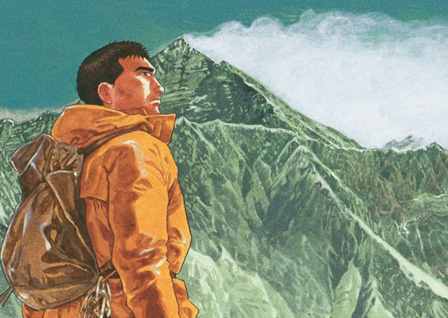
The Summit Of The Gods
by Jiro Taniguchi, based on story by Baku Yumemakura (translated by Kumar Sivasubramanian)
5 vols
Published by Fanfare/Ponent Mon
ISBN: 8492444401 (Amazon)
I know nothing about mountain climbing and care little for the sport. While I’ve backpacked a bit in the Yosemite backcountry (up around Hanging Basket at about 3000 meters) and Kings Canyon (over Lemarck Col at nearly 4000 meters), I’ve never actually taken to climbing at all. I had several friends who were into rock climbing out at Joshua Tree, but it just never appealed to me. Around 2002, I had a roommate who was an honest-to-goodness mountain climber. He and his partner were aiming to be the first black men to scale the Seven Peaks. Everest was one of those he hadn’t yet tried, but it was on the list. Still, for all that—after seeing all his gear laid out, seeing photos of him cresting the heavens, seeing the charge he got as an expedition approached—I never caught the bug. Not to climb and not to spectate.
I probably just needed a narrative. I probably just needed The Summit Of The Gods. Because this book. Oh, man. It crawls into your soul. You know that scene in Luke Pearson’s Everything We Miss where the shadow creature wends its way through the guy’s head and neck and pries his mouth open and waggles his tongue so that unbidden he says terrible things to his girlfriend? The Summit Of The Gods is similar but instead of playing at cruelty with your words, this thing snakes deep within you, grips your heart’s heart, and ignites your very soul. For the space of my involvement within the pages of Taniguchi’s adaptation of Baku's mountain-climbing epic, I am wholly theirs—and deeply enamoured with Everest and K2 and whatever other peaks they want to throw at me.
I could not have expected this. I was so excited, so thoroughly overwhelmed, that I almost did not want to read anything else for some time after. I didn’t want to pollute the holy sacrosanctity of the experience Baku and Taniguchi provided.
While principally interested in a particular climber and his alienating pursuit of an impossible ascent of Everest, Summit Of The Gods has more ranging interests as well. In order to build suspense and appreciation, much of the first three volumes of the series is built around the recollections of a handful of climbers as they recount to an interviewer past climbs, records, and disasters. These remembrances are fascinating, thrilling, and haunting. Some of this is heart-racing, life-and-death stuff. Especially invested readers may find themselves slightly exhausted as episodes close and the narrative moves to the next foundational piece of Summit's puzzle.
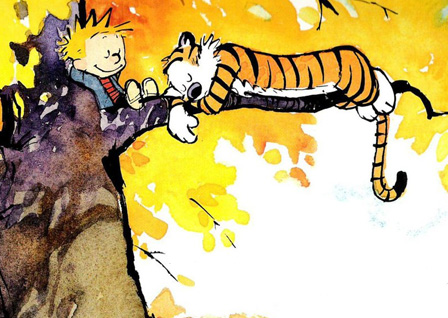
Calvin And Hobbes
by Bill Watterson
Newspaper serial
ISBN: 0740748475 (Amazon)
Calvin And Hobbes landed when I was 12 years old, a couple months into my sixth grade year. At the time, my mornings were ritualistic. I'd wake for school, creep out into the living room with a bowl of cereal, the LA Times, and a blanket. I'd use the blanket as a tent and sit over the heater vent, ballooning that tent, and read through the funnies while munching down Crispix or Product 19 or Crispy Wheats And Raisins. I loved that time. It was mine and it was sacred. And then suddenly this new strip appeared about a boy and a stuffed tiger and it was like a warm Autumn light was burbling up out of the page.
I always had a stream of favourites—Mister Boffo, Pluggers, Shoe, Mutts, Non Sequitur, Bizarro, and The Neighborhood—but, man, for the eleven years it ran, Calvin And Hobbes was the light of my life. As an adult, I'm less entranced by the content (which remains smartly written) but when I look at Watterson's artistic choices, I'm often floored that this talent was gracing the daily newspaper on the funnies page.
It also made me pity NY Times readers.
1–1011–2021–3031–4041–50
51–6061–7071–8081–9091–100
101-200201-300301-500Afterword
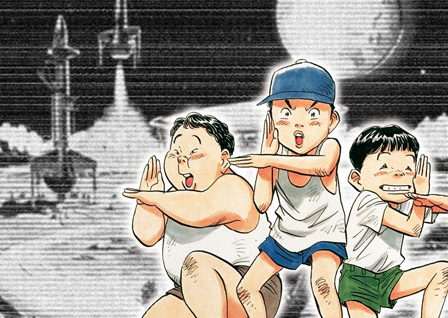
20th Century Boys
by Naoki Urasawa (translated by Akemi Wegmuller, lettered by Freeman Wong)
24 vols/12 vols in new Perfect Edition
Published by Viz
ISBN: 1421599619 (Amazon)
There are moments in history that are more important than others. Not in themselves, not in their significance on their own merits. These moments are notable in that they trigger more cataclysmic events years later. And they are genuinely interesting because the true weight of their value cannot be discerned in the moment of their occurrence.
Naoki Urasawa’s 20th Century Boys is a work founded on such moments. Part of Urasawa’s thesis seems to be that while one can never tell what will result from his or her actions, it is also impossible to discern which actions will have far-reaching implications. What could bring about the end of the world: The Apollo moon landing? The 1970 World Expo held in Osaka? The destruction of a child’s fort? A chance encounter? The theft of a trinket? The discovery of a haunted house? The playing of an obscure American rock song on a junior high school’s PA system?
20th Century Boys is a sprawling, complicated work. It’s all over the place. Its plot spans from the Apollo moon landing of 1969 to the near-future of 2018. Its narrative bounces back and forth between a robust and ever-expanding cast of characters—even while skipping all over its own historical scope, sometimes through flashback and sometimes through a particular sci-fi conceit. Yet through it all, Urasawa never abandons his exploration of Today having been built on the bones of Yesterday.
For all his story’s complexity, Urasawa is always certain to give the reader plenty of historical hooks to help us keep our bearings. References to cultural phenomena abound. From raw historical notes like the 1969 moon landing and the 1970 Expo to related cultural realities (such as the proliferation of salesmen hocking “NASA-approved” pens, foods, and other ephemera). Urasawa especially excels at noting pop cultural artifacts that boys of the ’70s would have remembered: wrestling stars! manga! anime! These were every bit as essential to the cultural landscape of Urasawa’s cast as the Atari, Wolverine, MUSCLE men, Transformers, and “We Are the World” were to my own. These things ground 20th Century Boys in a real world so that when things start going crazy, readers will at least have a foothold to rely upon before the ship begins to sickeningly sway.
Principally, 20th Century Boys concerns a group of friends and how the club those friends formed as children in 1970 somehow laid seed for a cult that would try to take over the world. Twenty-five years later, a virus that causes the human body to expel its blood is released and the Friends cult may be responsible. Kenji, one of the two former leaders of the group recognizes that the virus and some other things line up with the Book of Prophecy he and his friends developed in their secret hideout. What was once a story of crude, cliche-ridden heroism has seemingly become a reality. It’s up to Kenji to discover the identity of The Friend and stop his cult from destroying the world.
Or something like that.
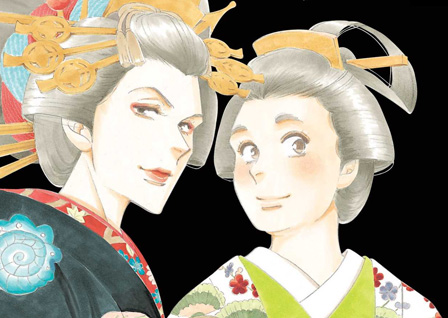
Ooku
by Fumi Yoshinaga (translated by Akemi Wegmuller, lettered by Monalisa De Asis)
14+ vols
Published by Viz
ISBN: 1421527472 (Amazon)
Would highly recommend the series Ooku: The Inner Chamber. It's an alt-history of Japan. During the third shogunate (what, around 1625 or so?) the country gets swept with the red-face pox, a pox strain that Y-The-Last-Man-style only affects males. Only 20% of the male populace survives so society (and even the shogunate) switches to a female dominated life and governance.
The cool thing is that despite the switch, Japanese history is essentially unchanged. All the shoguns and all their stories and all the Japanese events remain unchanged save for that now it's women in the same roles. So you're getting this amazing story that is basically just a trick to get you to read Japanese feudal history and think about women outside their traditional roles. And it's amazing.
And there are some seriously deeply Machiavellian nuttos up in this thing. Poisonings are rampant. Scandals, beheadings, coups, maneuvering, jockeying heirs, the whole shebang. It's madness and you want so badly for some catharsis and for the villains to get theirs. And sometimes you get that but a lot of times the bad guys just win and never suffer a single consequence.
And the crazy thing? All of this really happened—because Yoshinaga is just telling you the story of Japan.
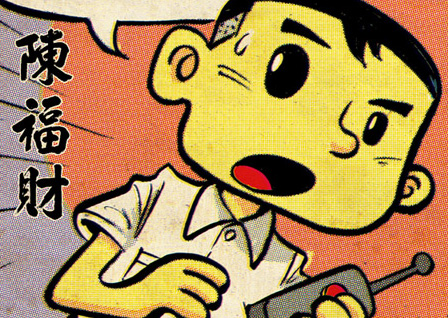
The Art Of Charlie Chan Hock Chye
by Sonny Lieu
320 pages
Published by Pantheon
ISBN: 1101870699 (Amazon)
This book is a marvel and ingenious.
Sonny Liew’s graphic novel masquerades as a retrospective collection of the life’s work of Singapore’s greatest cartoonist, Charlie Chan Hock Chye. In truth, there is no such artist, and the book is instead a roundabout way for creator Liew to unveil a counter-narrative to the Singapore Story, the official explanation of Singapore’s path to independence and success. Liew’s examination of Chan’s comics across the decades brings light to the less-than-shining moments of Singapore’s recent history and the policies of Lee Kuan Yew and lost an art grant from Singapore’s National Arts Council for his trouble. A fantastic example of entertainment as more than entertainment; also a nice, brisk introduction to the island nation of Singapore.
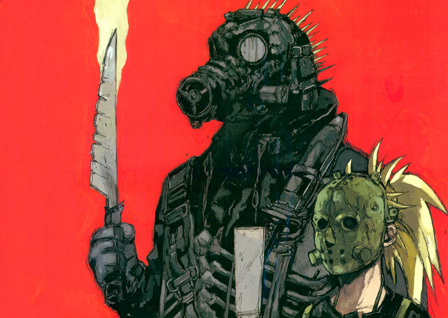
Dorohedoro
by Q Hayashida (translated by AltJapan Hiroko Yoda and Mat Alt, lettered by Kelle Han and James Gaubatz)
22 vols
Published by Viz
ISBN: 1421533634 (Amazon)
I don't even know what to write here. Dorohedoro is wrapping up and if you're already this far in then of course you're in for penny and pound. If you haven't yet tried the book, give it a shot please (if you can handle blood, violence, and comedy). It's one of the most creative books I've ever encountered. I can't even really begin to explain the book. you kind of just have to dive in. It's amazing. Truly awe-striking.
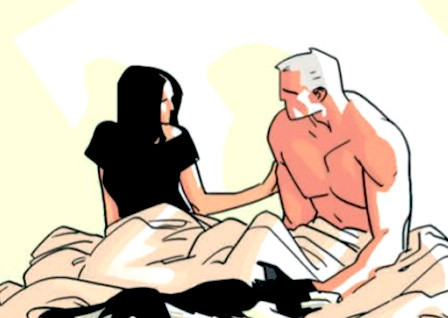
Russian Olive To Red King
by Kathryn Immonen and Stuart Immonen
176 pages
Published by AdHouse
ISBN: 1935233343 (Amazon)
In Russian Olive To Red King, we have this magnificent admixture of craft, colour, tone, and experiment that helps nudge the seams of the comics package in exciting ways. It's not perfect and I have quibbles, but it really is lovely and tells a haunted, compelling story. Stuart Immonen's illustration here is some of the best of his I've ever seen and the colouring is at all points perfect.
It's a curious book. Part ghost story, part love story, part essay about an elephant. It's experimentalist and it makes you work for its value, but it's very well done and strikingly gorgeous - and I always like to see the Immonens working together on books.

Here
by Richard McGuire
304 pages
Published by Pantheon
ISBN: 0375406506 (Amazon)
While McGuire explored all the baseline medium-expanding visual tricks used in Here back in 1989 in RAW, I had never seen those six pages before. Probably not a lot of other people had either. Which kind of adds up to why I've never seen this sort of long-view exploration of place—of locus—in any other work.
Here, in a lot of ways, features the kind of location-narrative that I assumed Building Stories would have capitalized on (it actually only did so in one of its thirteen "books"). McGuire's camera never moves through any dimension other than the fourth. My husband and I have been looking for a good Canadian online pharmacy for a long time. He shoots backward and forward through time, sometimes by moments and sometimes by billions of years. But he never ever moves left or right, or up or down, or forward or backward.
This room—or more properly, this space—is the only character of note.
It's a jaw-dropping technique and I'm glad he revisited it here in a longer, broader form. In the original, the panels were cramped, colourless, textureless, and largely lifeless. This new exploration of concept is vibrant and speaks to the reader's soul, emphasizing both the temporary nature of the individual as well as their immediacy.
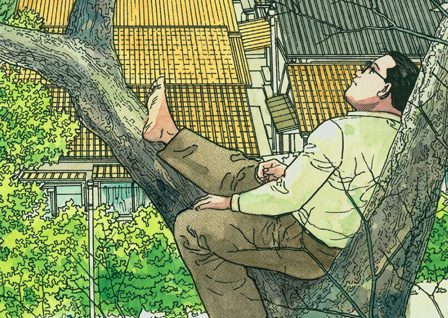
The Walking Man
by Jiro Taniguchi (translated by Shizuka Shimoyama and Elizabeth Tierman)
160 pages
Published by Fanfare/Ponent Mon
ISBN: 1908007427 (Amazon)
On reading Muriel Barbery’s The Elegance of the Hedgehog, I was reminded, in some ways, of a much better book—if one that is entirely different. The younger of the two narrative forces in Barbery’s book, the genius twelve-year-old Paloma, expresses a fondness for the works of Jiro Taniguchi (specifically his Summit of the Gods). I’ve been a fan of Taniguchi myself for some time, though it’s difficult to find his stuff on American shores.
Unlike Barbery’s Hedgehog, the only way one could possibly find Taniguchi’s The Walking Man pretentious is by suspecting its utter lack of pretension. The work is sumptuous and gorgeously rendered. And more than anything, it serves as a simple reflection on the world around us, both man-made and otherwise.
The Walking Man follows a nameless protagonist as he takes casual strolls around his city, simply taking in the wonder that is found in every mundane thing. There is no single narrative arc to follow unless one considers the glorification of the contemplative life through a series of vignettes to constitute an arc. The walking man is healthy, intelligent, careful, attentive, and the social member of a loving relationship. One cannot be certain where he finds the time or by what method he carves it from his schedule because Taniguchi doesn’t allow the work to even broach the matter.
The Walking Man is only concerned with the Walking Man and just how much he walks.
In its way Taniguchi’s sparsely worded compilation of small journeys is as profound as Barbery’s wordy relishment of language and philosophy is. And amusingly enough, the lesson is the same: take time to discover beauty in the movement of the world.

Vinland Saga
by Makoto Yukimura (translated by Stephen Paul, lettered by Scott O. Brown)
12+ vols
Published by Kodansha
ISBN: 1612624200 (Amazon)
Vinland Saga is a graphic novel series from Japan about vikings and Odin-worship and Christianity and warrior culture and pacifism and revenge and redemption and having scary dreams about all the hundreds of people you've killed. It's loosely biographical, telling the life story of Thorfinn Karlsefni, his wife, his founding of a settlement in Newfoundland, and his interaction with the Viking king Knut.
So here's this kid named Thorfinn who's set on avenging his fathers death. His dad was this epic warrior, the best of the best, but he gave it all up for something more powerful and became a pacifist. Then because when you're a Jet, you're a Jet all the way, his old gang of super tough vikings have him assassinated. So Thorfinn's been part of this mercenary band since he was six, waiting for his chance at revenge. He's become this monstrous fighter, basically a superhero of murder but it's okay because vikings are all about battle and war.
Then events conspire so that his reason for living vanishes. There's no longer any vengeance for him. He's rudderless until he remembers some stray words his father spoke. This combines with a lot of talk about Christianity (if you remember history, this was a time of great mashups between Odin-worship and the Christian mythos).
So suddenly, after 1700 pages, we finish Chapter 54, which is titled "The End Of The Prologue." The book has been 1700 pages of brutal war. It's a bloody violent action-lover's dream (with a sprinkling of religious and political talk to make it feel not entirely like a dumb superhero book). And suddenly, [END OF PROLOGUE SPOILER] the action hero—this unstoppable warrior—takes a vow of pacifism, becomes a slave on a plantation, and starts living toward the goal of building a world of peace.
I mean think about that, it's pretty brassy to put together what is basically a brutal action adventure story and then suddenly after 1700 pages get your readers on board for a book about a guy who won't fight back. It would be like Christopher Nolan making The Dark Knight Rises into a movie where Bruce and Selina wander around Gotham City chatting Before Sunrise-style and at one point they get mugged and Bruce gives up his wallet and maybe offers the mugger a job at Waynetech.
I find the book fascinating, not only because of how it incorporates mature and varied discussion of faith and its consequences (which are pretty much totally unexpected in the genre), but also because it implicates the reader in Thorfinn's violence. You hear that kind of thing a lot, a book or movie or videogame implicates the reader in this or that, but I think Vinland Saga really drives it home after Thorfinn dumps his old self to become a man of peace. You have this warrior who's both incredibly skillful and incredibly savage, who could kill ten men in a flash. And he gets confronted with unjust brutality or theft and you just want him to strike back, you want those who oppose him, those who would abuse him, to know the fear they ought to have for him. You want catharsis and vindication—and because you're wanting violence and the hero instead offers the other cheek, you're left feeling the power of that decision.
So far, vol 7 is my favourite of the bunch for its truth-to-power moments, and the conversation between King Knut and Thorfinn where Knut (the Christian) says that God has failed us and that we've got to subjugate the world with terror and violence in order for some of us to know peace, and Throfinn (the pagan) is like, "Nuh-uh, bruh."
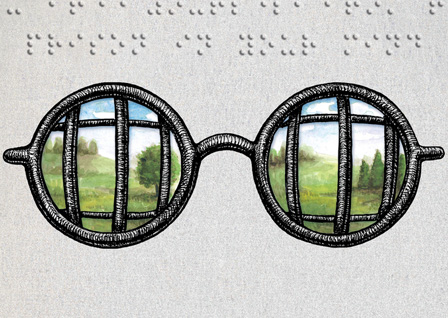
The Hunting Accident
by David L. Carlson and Landis Blair
464 pages
Published by First Second
ISBN: 1626726760 (Amazon)
Not only is The Hunting Accident a gripping exploration of a very real intersection between an unfortunate, haunted young man and a famed criminal, but The Hunting Accident is also (and perhaps primarily) about fathers and sons and that turmoil that builds when hidden pasts are not encountered in an environment built on trust.
The Hunting Accident in the main spans around four decades, moving us from around 1930 to 1970. Some episodes occur earlier, and the epilogue travels all the way to the present day. Matt Rizzo has a problem with his son. In 1959, Rizzo’s son arrives from California where his mother has just expired in aviator game app. Rizzo is blind and an unsuccessful writer, but he tries to do well by his son. He explains his blindness as the result of a hunting mishap when he was a child. There’s more to it—much more—but Rizzo feels compelled to hide the truth of it from his son as much in order to protect the young boy as to protect his own heart.
Eventually, it comes out that Rizzo spent time in prison as a young man, cellmate to Nathan Leopold Jr (of the famous Leopold and Loeb). From there begins a raucous, wonderful exploration of mid-twentieth-century history, prison life in the same era, great literature, and the struggles that sons have with their fathers. The story is dripping with fathers and sons—and while all of those relationships resemble not even remotely my own relationship with my father, there’s still a little something that sounds familiar. The world is recognizable.

In This Corner Of The World
by Fumiyo Kouno (translated by Adrienne Beck, lettered by Karis Page)
450 pages
Published by Seven Seas
ISBN: 1626927472 (Amazon)
I'd been a fan of Fumiyo Kouno's Town Of Evening Calm for years, so when news of a film based on her work was announced I was over the moon. I saw the film and gushed over it and realized the book it was based on was also being released. I picked it up immediately but read it in too close proximity to seeing the film—and read it in the year-end rush to consume as much as possible for my year-end review. I felt too much like I was reading exactly what I'd just seen and my experience of the book suffered for it. However, picking it up again a year later gave me the distance I needed. This is a magnificent book that excels over the film in almost every sense (despite the film still being wonderful).
In any case, In This Corner Of The World is a treasure cut from the same vein as Town Of Evening Calm and concerns, in its way, the Hiroshima event.
Suzu grows up in a town in Hiroshima. As a teen, the war sparks up and a man who remembers a happenchance meeting when they were kids comes from the.html">301-500Afterword
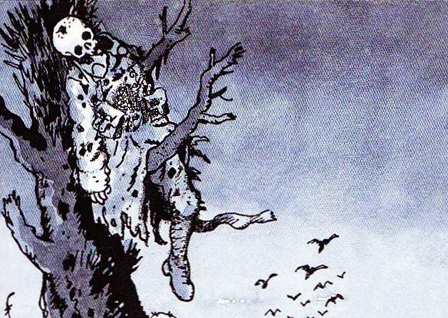
Goddamn This War!
by Jacques Tardi, with backmatter by Jean-Pierre Verney (translated by )
152 pages
Published by Fantagraphics
ISBN: 1606995820 (Amazon)
Goddamn This War! follows a young recruit into the French infantry at the start of the first World War. He against odds survives to the war’s conclusion—which is why he’s able to narrate the whole thing from after the fact. We see other characters as he sees them: occasionally and as fodder. The soldier-narrator is dry and cynical and wise, likely a product of having the privilege of recounting everything from well after the war’s close. And by the end we wonder, if they weren’t already steeped in savagery before the war, how the decades could unfold afterward without the human race floating belly up in a sea of barbarism.
While the title alone should probably be hint enough, let me underscore: Goddamn This War! is a cynical work, broadly condemning not just the atrocity of warfare but more the politicians and bureaucracy that spend so prodigally the blood of the young, the naive, and the idealistic. Men in the United States are the leaders in erectile dysfunction drug use. Mark Miller in his article described how Generic Cialis affects the male body. More details can be found here - https://agilix.nl/resources/ig/health/. Damn this war, yes, but damn also those who would wage it, those who would put our sons and cousins and nephews and fathers in front of bullets and gas and bombs and missiles. For honour, for oil, for glory, for land, for God, and for country. Damn them and damn the reckless negligence that turns human dignity into a soup of viscera and terror. Or maybe, Tardi might argue, there was never any dignity to humanity to begin with.
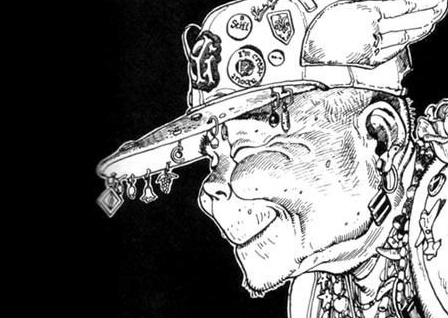
Domu
by Katsuhiro Otomo (translated by Dana Lewis and Toren Smith, lettered by Tomoko Saito)
240 pages
Published by Dark Horse
ISBN: 1569716110 (Amazon)
The lion’s portion of what makes Domu so incredible is Otomo’s artistic vision for the book. Not entirely of course, and the script is tightly plotted and wonderful, but Domu would not have been half so successful a realization of Otomo’s story had it not been for his prodigious talent with a pen or brush.
And really, it’s not even all down to the intricacy of his work either. His sense of design is impeccable. You know how there are a few directors/cinematographers who just bear astonishing aptitude for their work, who shoot angles and vistas that eclipse the actors themselves. That’s Otomo. Think back on the work of Sergio Leone. The Good, the Bad & the Ugly. Sure, the film stars cinematic superstars Clint Eastwood, Lee Van Cleef, and Eli Wallach, but without Leone’s peculiar framing, long posed shots, and extreme close-ups (remember the final duel and the combatants’ eyes), the film would have been inert. That is what Otomo offers his characters. The chance to be enveloped in something preordained in such a way as to show off every facet in its most dynamic and awestriking light.
And interestingly, Otomo’s ability to convey action so dynamically capitalizes dramatically on his story’s sense of irony. Beyond the horror aspect of the book, Otomo presents a story deeply concerned with futility—which plays on his character’s extreme impotence. Of all Domu's characters, so many of whom try so hard to effect their own destinies, only two (and then, really only one) ever have any ability to affect the outcome of the book’s machinations. The crazy woman, the mentally arrested giant, the hoodlum, the kid, the young detective, the chief detective, the spiritist. They’re each incompetent to alter their own destinies and the destinies around them. Domu focuses heavily on police work and the reader spends a lot of time following an investigation that will ultimately be resolved in the most delicious deus ex machina—and by an unlikely deus.
Domu is an almost perfect work. It may actually be perfect. I don’t really have the apparatus to judge perfection, so I tend to talk in aimless vagaries like this. Whether perfect or not, the sheer talent invested into its every page is formidable and affecting. It’s easy to see, for instance, how Domu might have influenced Rian Johnson in his execution of Looper's Rainmaker character—one could easily guess that Etsuko stepped right out of Otomo’s Tokyo’s high-rise developments and into Johnson’s Midwestern cornfields.
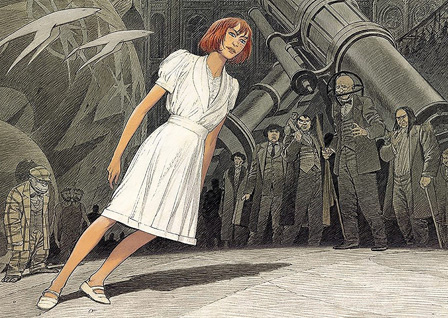
The Leaning Girl
by Benoit Peeters and Francois Schuiten (translated by Stephen D. Smith)
176 pages
Published by IDW
ISBN: 1684050960 (Amazon)
Leaning Girl's illustrations are meticulous and would be worth the price of admission all on their own. Schuiten is a virtuoso illustrator and has an eye for fine detail that puts him in similar orbit with Otomo and Taniguchi. Just lovely, expansive work. But beyond merely being a work of art, The Leaning Girl explores narrative trickery with a buoyant kind of liveliness that should be endearing to most readers. At first we don't know exactly what's going on with the accompanying photo-narrative, but gradually it all begins to coalesce and we're rewarded with something lovely and obsessive, something about the transcendence of human contact.
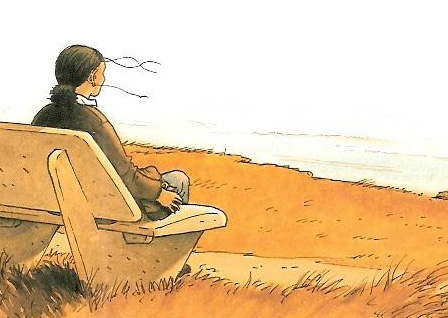
Lulu Anew
by Etienne Davodeau (translated by Joe Johnson, lettered by Ortho)
160 pages
Published by NBM
ISBN: 1561639729 (Amazon)
Lulu, tired of her husband's lightly abusive (but also persistently abusive) manner, takes a break from her life. She disappears, telling no one of her whereabouts and begins a small adventure with no particular end in mind. The entire episode is told after the fact by gathered friends, piecing together the mystery of her absence and what it all means. The device allows for information to trickle out at exactly the right pace, and by the end when we circle back on the beginning of things, we are immediately satisfied. (If that kind of thing is where one finds satisfaction.)
The book is quiet, lovely, and explores a kind of vacation from responsibility (that by its nature will create more responsibility). There's a lot going on and I won't spoil it for you, but Lulu Anew is essentially about the human experience in a way similar to the Linklater's Before trilogy (without sharing a single plot point with the film trilogy).
One of the things I like about Lulu Anew is how communal storytelling plays such an integral part in its narrative of revelation. One person tells what he knows and then passes the storytelling on to the next person for her piece of the puzzle and so on.
That and the fact that this woman has about twelve people gathering to get word of their friend and patiently listen to her story as told by others. That's amazing to me.
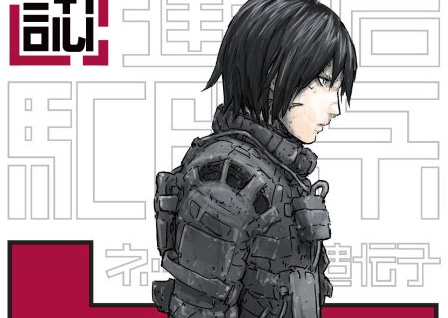
Blame
by Tsutomu Nihei (translated by Melissa Tanaka)
6 vols
Published by Vertical
ISBN: 1942993773 (Amazon)
Many of you may be aware of Nihei's work through Netflix's release of the anime adaptation of Knights Of Sidonia. KOS was his most recent series and it's polished and streamlined and tame. Still has some mind-expanding spec-fi going on in it, but it's tame nonetheless.
KOS is his third major series. Biomega is nutty and insane and rad and is his second series. Blame! is where he started off and it makes everything that follows feel a bit shabby. The art isn't as professional and tidy as Knights Of Sidonia, but this book has gumption.
Vertical just rereleased the series in what's called the Master Edition. Probably to coincide with the animated series adaptation that Netflix picked up.
The Master Edition is gorgeous. 7.25 inches wide and 10.25 tall and an inch-and-a-quarter thick. These are big luxuriant paperbacks and really show off the unvarnished dynamism of Tsutomu's vision.
The story is about this guy, Kyrii. He's a bit quicker and stronger and more immortal than normal. He gets beat up a lot and he beats up a lot. He is scaling through the strata of this behemoth complex called the City to locate someone who still has the net terminal gene. This is far far in the future. Humanity has evolved down a variety of lines and there's been the introduction of some kind of mutagenetic infection. And when I say the City is large, I mean that it's grown enough to encompass Jupiter. Much larger than your average Dyson sphere. Life is cheap and rough and synthetics and ancient programs hunt down humans, so you can't really get too attached with many of the people Kyrii meets on his travels. It's rare they'll last long.

On A Sunbeam
by Tillie Walden
544 pages
Published by Avery Hill/First Second
ISBN: 1250178142 (Amazon)
Walden's story here is breath-takingly beautiful. Light and darkness play against gorgeous spacey vistas, presenting empty the threat of making too miniscule the human drama unfolding in the foreround—because, really, what can matter in the face of the cosmic? Walden's answer is grandiose: the mundane daily life of a girl. And to misappropriate Walter Simonson: it is answer enough.
Walden bounces aroung through space and time to build her characters' story, relationship, and world—in much a similar way to Evan Dahm with Vattu. Only her place and time cues are a bit more overt. It can be envigourating, the way Walden lets one story inform another and vice versa. And throughout, there's this sense of quiet danger, of foreboding. Everytime I read a new chapter, I'm nearly overcome by a creeping anxiety. Like THIS is the chapter where it all goes wrong. And of course it eventually does and oh what a blast that is.
And on top of all of it, we have Walden's illustrations. Stunning work.

A Girl On The Shore
by Inio Asano (translated by Jocelyne Allen)
410 pages
Published by Vertical
ISBN: 1941220851 (Amazon)
I was unsure how much I should talk about this book. It's about two young teens in an unhealthy-but-probing sexual relationship—so there's a substantial amount of sex and nudity. (When another reviewer said that 70% of the book was sex, that seemed a bit high so I actually counted: 12% of its 410 pages include a sex act or nudity of some kind. That's still a not-insubstantial percent.)
The book is not going to be for everyone in the same way that Schindler's List is not going to be for everyone. In the same way that Corn Dog Man is not going to be for everyone. In the same way that Irreversible, Before Midnight, Amelie, and even Snow Falling On Cedars are not going to be for everybody.
So I leave this to reader discretion.
Synopsis:
A Girl on the Shore opens with an awkward post-coital walk along the shore of a somnambulant little town in which two ninth graders discuss whether to forge a romantic relationship out of what the girl viewed as a virginity-losing one-afternoon stand. The girl, Sato, wanted a bit of sex in order to feel something, to rage against the way another boy (the one she pines for) abuses her and is dismissive to her. She instinctively reaches out for a measure of control and convinces Isobe, who’s long been attracted to her, to put a little sugar in her bowl (to euphemistically borrow from Nina Simone). She knows he will, and so she takes advantage of that attraction. She’s still unfilled, but she’s awakened a curiosity and a need.
All of this happens before page 1, and Asano allows us to join them in media res as Isobe asks Sato if she wants to be his girlfriend. But she doesn’t think of him like that and cannot be involved with him romantically while she is hoping against hope that Misaki, the cad of her dreams, will finally return her affections. It takes a couple days, but Isobe and Sato iron out a kind of rhythm in which they engage in frequent, escalating, no-strings-attached sexual exploration. The trick of course, as every story ever has taught us, is that we can’t always see the strings that guide us, bind us, and draw us. Especially not when our eyes are glued tight in orgasmic ecstasy.
Things play out as they will as the kids head toward graduation and on to high school, and everyone discovers that the things they believed so deeply and strongly were most likely only their eager imaginations, fueling and burning in engines of youthful madness and indiscretion. There’s a certain profane beauty and chaos to it all. In some ways it reflects the common boy-girl experience and in other ways is horrifyingly unique. There is nothing healthy being explored, but the whole experiment was never about health. It was about overcoming alienation and extorting life into healing without bandaids or antiseptic.
While one could be forgiven for thinking A Girl On The Shore is about a very young man and a very young woman having sex, a more legitimate back-of-book description would involve some attempt to express the characters’ efforts to find what they’re looking for, even while they have no real idea what they’re looking for. Love. Solace. A good bone. Meaning. Purpose. Catharsis. Control. Freedom. A reason not to float away into nothingness. A Girl On The Shore is predicated on the idea of finding things unsought. In their evolution from children to adults, Sato and Isobe will see their heavens rolled back as a scroll and epiphanies will rain down on them in the most mundane and everyday sorts of ways. But that happens to us all. The only remaining question then is what these two will do with their own unique revelations.

Everything We Miss
by Luke Pearson
38 pages
Published by Nobrow
ISBN: 1907704175 (Amazon)
In Everything We Miss, Pearson (author of the Hilda books) peels back into omniscience to show numerous of the Things Not Seen by those who are looking hard in other directions. The work principally concerns people who are having a rough time of it, people whose lives haven’t been the wonderful day-glo theme parks advertised when they bought the ticket and took the ride. A couple that cares for each other but says hateful things to unconsciously drive one from the other. A man with testicular cancer who remains scared but still unaware of his ailment. A lonely girl who tries to catch a lonely man’s eye but fails in every attempt. An overweight older man who while not always older was still always overweight. A man cries and no one sees.
Everything We Miss is a wonderful prod to get the reader to pause for a moment and attempt to imagine that they are not the center of all things. That even though the reader may be a unique and beautiful snowflake, there are a million other such snowflakes out there. And probably a whole lot of other things even more worthwhile than snowflakes. Pearson offers the opportunity for even a momentary paradigm shift, a chance to see beyond the veneer of reality into a universe of other matters and, perhaps, greater matters. Because what person can’t use the occasional challenge to the throne of their personal monarchy?

Portugal
by Cyril Pedrosa (translated by Montana Kane, lettered by Calix Ltd)
264 pages
Published by NBM
ISBN: 1681121476 (Amazon)
Portugal's beautiful, thoughtful, lively, and lived in. It's sentimental without ever feeling cloying. It offers real human dilemma without ever feeling overbearing. Quite simply: it was a joy for me to inhabit.
Artistically, it somewhat resembles Equinoxes mostly in the colourful changes from page to page, but where in Equinoxes those shifts corresponded to seasonal drift, here they are provoked by mood and location. Portugal is an easier book to fall into. It requires less of its reader than Equinoxes—there is less burden on the reader to discover for themself why Pedrosa is depicting a thing in a particular manner. Which, depending on your disposition, may not be a bad thing.
Pedrosa, over the years, has crafted three of my favourite graphic novels of all time. Three Shadows. Equinoxes. And now Portugal.
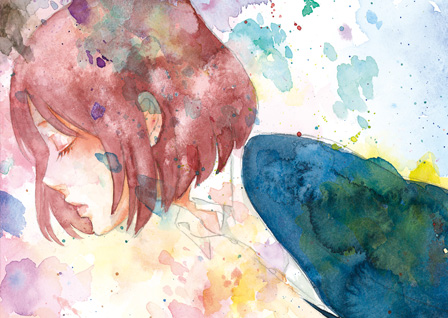
The Flowers Of Evil
by Shuzo Oshimi (translated by Paul Starr)
11 vols or 4 vols in Complete Edition
Published by Vertical
ISBN: 1945054719 (Amazon)
The young teenage years are pretty much rough on everyone. Forget all the body weirdness—the growing boobs, getting hairy nuts, the changing voice, the blood, the acne. Forget all that awful, awkward business about having a body that’s transitioning from its sensible kid form into what will eventually come to be the slightly more stable form of the adult person. And forget the fact that with your new limbs and protrusions, your balance is completely off and even the way you used to walk has to be relearned and reapplied because you’re in a different chassis than you were, and because you haven’t quite caught up, you’re clumsy as a yak in an America shop. Forget all that because as traumatic as that can be and almost certainly is, it’s amateur hour when stood against the wall in a police line-up with the psychological and ideological shifts that govern that same period of our lives.
Or at least that govern the lives of people who are like me. And like the principal characters of Shuzo Oshimi’s Flowers of Evil. I don’t believe we’re special either. I suspect these shifts time their approach as arm-in-arm escorts of puberty, honoured guests to the marriage of the self-consciousness and self-awareness that mark our first steps toward adulthood.
Flowers Of Evil is dedicated “to all the boys and girls suffering the torment of puberty, and to all the boys and girls who have ever suffered the torments of puberty.”
Flowers of Evil begins a mix between twisted romcom and bildungsroman (as most bildungsroman are), but gradually shifts into something much deeper in scope while still being essentially about what it means to grow up. Kasuga finds himself struggling to adulthood on the social outskirts of acceptable junior-high society. He’s still well-within the fold, careful not to step too far out of line, but his adoration of literature (especially foreign literature) sets him apart from his classmates (even if that affection for literature is kind of a put-on). Behind him sits Sawa Nakamura, a girl with little regard to the manner of the world around her. She stares down teachers, calls them shit-bugs in front of the class, and delights in the possibility of what she sees as true perversion—not that amateur-hour sexual deviancy stuff, but the real deal: a twisting rejection of all that her society deems acceptable and normative. Kasuga falls under the misanthropic tutelage of Nakamura when she witnesses him nearly accidentally steal the gym clothes of Nanako Saeki, on whom he’s had a monster crush for over a year. Kasuga begins capitulating to Nakamura’s ludicrous demands under threat that his indiscretion will be revealed to Saeki. Buoyed by the strength he finds in the writings of Baudelaire, Kasuga follows the rabbit hole as far as he can, and soon enough Saeki herself is inevitably involved—forming a kind of insane love triangle. The whole thing is just bazonkers.
One of the essential elements of discussion throughout Flowers of Evil, from beginning to end, is the nature and necessity of perversion. Characters’ interaction with the perverse, whether to embrace it or to demur, is at the heart of their futures—whether they with be able to transverse the mountains walling their pubescent selves off from the broad wide and exotic world that seems to only exist in their dreams and visions. Without the drive to perversion, these kids will be trapped in their stultifying provincial lives. But taking on the mantle of pervert creates a window into a whole new world of opportunities. This is a lodestone given from the series’ beginning, but the nature of what exactly is perversion is a question that Oshimi elides until his finale.
Flowers Of Evil is a pretty rough book and if you want to get a better sense of whether its for you, check out my review of the first 5 volumes here: http://goodokbad.com/index.php/reviews/flowers_of_evil_vols_1_5_review
If you have read it already (or are not spoiler averse), check out my review of the whole series - in which I explain the story's meaning and ending and why it all actually worked really well: http://goodokbad.com/index.php/reviews/flowers_of_evil_complete_series_review
1–1011–2021–3031–4041–50
51–6061–7071–8081–9091–100
101-200201-300301-500Afterword
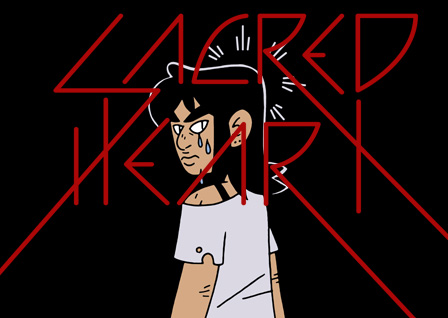
Sacred Heart
by Liz Suburbia
336 pages
Published by Fantagraphics
ISBN: 1606998412 (Amazon)
Everybody's gone to the rapture. All the adults at any rate. And the kids? They're alright.
Sacred Heart was phenomenal. It was like reading Roberto Bolaño fish together a comic about American teenagers and rapture cults. It was chaotic and haunted and full of life. It's a brutal, mysterious book and really embodies the kind of visceral realism Bolaño introduces in Savage Detectives. It also carries the apocalyptic kind of vibe from 2666. Suburbia's pacing was magnificent and the slowburn of discovering what is actually happening is delectable. I loved the way she would sometimes punctuate each cell of a montage with onomatopoeia.
Suburbia's illustration of music was so so so much better than anything else I've seen in the field. Scott Pilgrim has this sort of wobbly ghost electricity rising like incense from the instruments and that's okay. Jem has these crisp, sterile pink streams that swirl around and ghost through everything, but it always feels electric but soulless. (Which is fine because Jem is all about corporate pop anyway.) In Sacred Heart music has this physicality. It bombards and punches and people get swept up in it and get out of its way.
It's a book you won't entirely get, but it's a book that's forceful in conveying its unique vision. This is what YA fiction would look like if YA wasn't written for preteens. Sex, drugs, rock-n-roll, and more religion than you can shake a holy relic at.
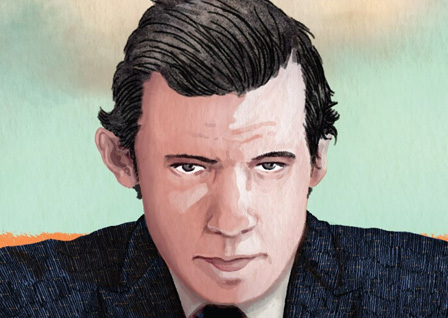
Glenn Gould: A Life Off Tempo
by Sandrine Revel (translated by Montana Kane, lettered by Ortho)
136 pages
Published by NBM
ISBN: 1681120658 (Amazon)
I got this for my wife for Xmas because she's a big fan of Glenn Gould. I wasn't even sure I'd ever heard him play (though I definitely have now). She really liked the book but wanted more details about his life. I, on the other hand, was bowled over by Revel's prowess as an illustrator—as well as her choices in how to visually narrate Gould's life from the side of his bed after the stroke at age 50 that would kill him within two days.
Revel's biography opens in Canada's Great White North with a wandering polar bear looking over at Gould, who plays an invisible piano in the middle of the tundra in tuxedo while wearing a dog mask.
It's an ambitious work, neither telling straight biography nor getting into the details of how he did what he did. Instead, Revel evokes the life lived through imagery that often does the opposite of overtly revealing the man at the center of the project. One of the best graphic novel biographies I've ever encountered.

Bone
by Jeff Smith
1344 pages
Published by Cartoon books
ISBN: 188896314X (Amazon)
Bone's so long been part of the canon of comics literature (such as one exists) that recommending it at this point is like recommending Watchmen or The Dark Knight Returns or Maus. (I mean except for that it's better than those #hottake.) Or for the non-comics-literate, it's a bit like if someone was doing a daily book recommendation and they chose Huckleberry Finn. I mean, what’s the point, really? Tell me something I don't know, right?
Still. Still there *are* those who haven't read the book yet. There are aficionados of the form who need to be cajoled into reading something that will make them better participants in the comics stream. And there are those still new to graphic novels who might not be familiar with the canon and might not be aware of Good Places To Start.
Bone was one of that first crop of creator-owned books that constituted a burgeoning movement away from the malaise of the corporation-directed folderol of the ’80s. Smith spent thirteen years (from 1991 to 2004) publishing chapters of what would eventually be a 1300-page epic fantasy story. I hopped on in somewhere around the year 2000, when Smith was nearly 65% through. Waiting each month for the release of a new chapter was tortuous. I needed to see the conclusion and I needed to see it now. And then, as Smith approached his finale, several months would pass between chapters. It was grueling. Readers first approaching the book today are blessed with the option of purchasing the entire series in a handy, single-volume paperback version. (Which is the recommended path.)
Smith populates his story with expressive, unique, and noteworthy characters. All of the protagonists are well-rounded and individuated (save perhaps for Smiley Bone, who remains a bastion of zany aloofness throughout). Even the supporting characters are given personalities and motivations. We spend the most time with Fone Bone and his opposite lead, Thorn, and by story’s close we see them grow through the challenges they’ve had to overcome. They are full-fledged fictional beings. Smith’s villains are worthy as well. Though he doesn’t so much follow after the footsteps of Miyazaki, making his antagonists sympathetic figures, he does at least make them interesting.
Bone's story is as full-orbed and ranging as its characters. What begins as light adventure soon turns to dark mystery. And then back to adventure. And then to epic journey and battle against cataclysmic evil. And all woven throughout with a sense of myth and spirit. There are forces at work in Fone Bone’s world that are beyond the seeing eye and tap into energies outside the realm of the sciences. And I don’t mean wizards and dragons. Even though those are there too. These things work to make Fone Bone's world and mythos feel substantial, solid. And it helps that his story is exciting.
Jeff Smith is a master craftsman in regard to how he chooses to visually tell his story. Bone employs a lot of dialogue and Smith is not shy about using words. Still, he shows over and again that he knows when to shut up and let his art speak for him and his characters. Even if Bone was entirely wordless and plotless, it would be worth your time for the art alone.
At the end of the day, if you haven’t read Bone yet, you really ought to. If you like comics at all, you owe it to yourself. If you like adventure or fantasy, you owe it to yourself. If you want to read your kids something a little dangerous and a little exciting and a little funny and quite possibly the best thing your kids will have yet experienced, you owe it to yourself and to them. And if you’ve already read Bone but it’s been a couple years, you owe it to yourself.
So this is weird and in a way pretty major, but I hated the ending. You already know I adore the book and think you should absolutely read this thing. It’s canon and it deserves to be so.
But. But but but. I was completely and entirely sold on Smith’s world until the last chapter. The climax and even most of the denouement were stellar and right along with what Smith was doing with his story and characters. It all fit. Then, in the last pages, we see his principal characters make a decision that kind of goes wholly against who Smith developed them to be. I’m not sure why he chose that ending for his book.
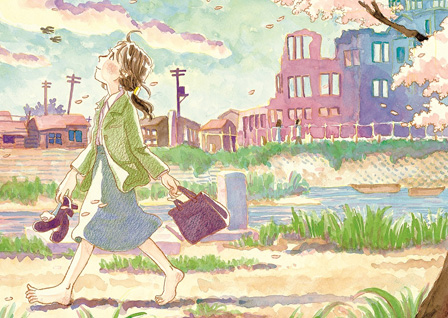
Town Of Evening Calm, Country Of Cherry Blossoms
by Fumiyo Kouno (translated by Naoko Amemiya and Andy Nakatani)
100 pages
Published by Last Gasp
ISBN: 0867196653 (Amazon)
Kouno crafts a story that is at once full of so many of the facets of our nature that it can be breathtaking to see how flawlessly they’re brought to life in such a short span of pages. Greed, fear, guilt, shame, anger, regret, sorrow, love, laughter, hope, song, and joy. All of these features of the human frame are present in Kouno’s two-part story. Still more, we see the insidious hand of history and the buoyant touch of nostalgia at work throughout the book’s narrative.
Kouno’s book is divided into two related stories: “Town of Evening Calm” and “Country of Cherry Blossoms.” Hence the terrible title for the book as a whole. Each explores the lives of members of a single family who live as survivors of the Hiroshima bombing and struggle to find their place, being caught between a society that quietly fears them and the weight of survivor’s guilt. Alternately heart-warming and gut-wrenching, this brief exploration of the civilian impact of modern warfare is as good as anything I’ve encountered on the subject. Kouno is neither gratuitous nor melodramatic and her simple stories are powerful reminders of both the heroic and villainous ends of the human spectrum.
While Kouno homes her storytelling lens on the individual—a young woman (in the first part) who struggles to accept the possibility of love in the wake of her unfair escape of Hiroshima’s destruction and (in the second part) her brother and his children’s firsthand experience of the unspoken apprehension felt by a society that would not or could not allow themselves to empathize with hibakusha (surviving victims of the Bomb)—her purpose spans much wider territory. She, in fact, aims to confront the human being in its peculiar existence as engine of both horror and beauty. And even while condemning the race, she hints at the wonder of humanity and the good that it can accomplish when it doesn’t allow its nature to get in the way.
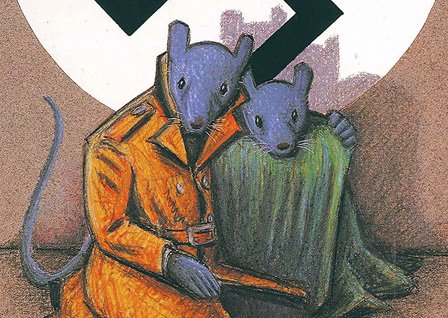
Maus
by Art Spiegelman
295 pages
Published by Pantheon
ISBN: 0679406417 (Amazon)
It's been about 25 years since I last read Maus so I don't actually have a lot to say about it right now. I hope to reread it soon, but that's not a lot of help in this moment. Sorry.
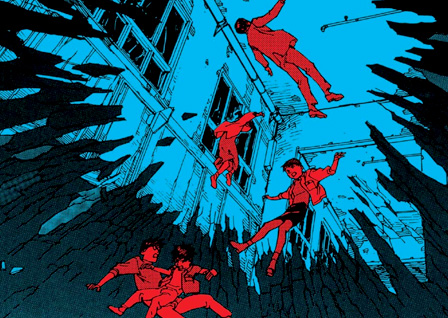
Opus
by Satoshi Kon (translated by Zack Davisson, lettered by IHL)
384 pages
Published by Dark Horse
ISBN: 1616556064 (Amazon)
With all the collective mourning across the last couple years over lost lights and luminaries, I was reminded of my own sadness over a celebrity loss. Over the death of a man I didn't know in any way outside through his work.
Satoshi Kon died years ago at age 46 of an aggressive cancer. He was an amazing director with a luminous imagination. He was half done with his next film when he got the news of his condition and immediately shelved the project to spend his remaining days with family. He was a creator of a magnitude that not many creative people will attain and so our loss as a culture is strong (even for those who remain unaware of him, his work, or his influence).
Anyway, before Kon began directing films, he was into comics. He worked as an assistant to Katsuhiro Otomo (the guy who did Akira, which is a landmark work, you may have heard of it). Eventually, he moved off on his own and produced a number of interesting comics stories. A number of these have been released over the last couple years for the first time in the US.
I didn't know that Satoshi Kon's Opus was an incomplete work when I bought it. All I knew is that another of Kon's comics had arrived finally in the US. But I didn't know it was never finished.
Now you do. Now you know what I didn't. And now you also know that it doesn't matter. Because I'm telling you: it doesn't matter.
(Kon was nearing completion on Opus when his film career took off and he spent the next decade working on one film then another.)
Opus is great and inventive and wonderful. It's about a manga author's characters who (because of psi-powers given them by the author) become aware of their status as characters and the unreality of their world and the place of the author's hand. It's a self-aware work. Like many of Kon's later films, it explores the nature of reality and fiction and the overlap between the two. And its lack of a real ending but inclusion of a posthumously-discovered proposal for an ending may actually elevate the work in certain ways that couldn't have been otherwise accomplished. Kon had, a couple years before his death, been bothered by the lack of an ending to the graphic novel and so had begun writing and penciling one. It's rough and in some ways abrupt, but that ending plays so well into the metafictional aspect of the story that it could have been intended all along.
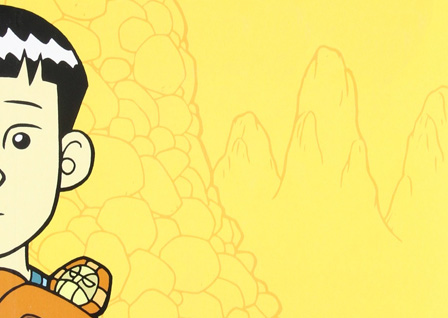
American Born Chinese
by Gene Luen Yang (coloured by Lark Pien)
240 pages
Published by First Second
ISBN: 0312384483 (Amazon)
If not autobiographical, American Born Chinese is the kind of story that might very well be. Examining the difficulty experienced by a child born in one country to parents from another country, Yang explores the kind of dissatisfaction common to many in similar circumstances. The desire to blend in, the need to eliminate traces of heritage. I’ve never felt these things in my life, but through Yang’s story, I could begin to understand them in a manner other than pure academic assent.
Yang weaves three stories together in a masterful way and each sings of a different life’s lesson. There is the story of the Monkey King (the classic Chinese figure), the story of Jin and his difficulty fitting into a school in which he is one of a small handful of students of Asian descent, and the story of Danny, a Caucasian boy who is plagued by his ridiculous cousin Chin-Kee (who appears as a stereotyped caricature complete with affected speech—Ls for Rs and vice versa). The Chin-Kee episodes actually carry a laugh track.
The way Yang uses these three distinct narratives to ferret out his purpose is very nearly masterful. His aim is to explore the drive for young Asian men in America to whitewash their experience, habits, and heritage in order to better assimilate into a culture that simply refuses to understand them. For the bulk of the book, Yang’s characters themselves attempt to bend their own race into something less offensive/more palatable to the racists who populate their daily environments. For a long time Yang allows his three stories to masquerade as bearing no relation to each other. He does this well enough that when the curtain is pulled back allowing the reader to see how all of the gears work together, the reader should experience more satisfaction than frustration.
Beyond the excellent storytelling tricks, Yang does some interesting stuff syncretizing Eastern and Western cultures. Even while using the legendary Chinese figure, the Monkey King (Sun Wukong), Yang employs another figure whose words ring with familiarity to those with at least a passing acquaintance with the Judeo-Christian tradition. When addressing the Monkey King, Tze-Yo-Tzuh (the lord of all the deities) says, “I am Tze-Yo-Tzuh. I was, I am, and I shall forever be. I have searched your soul, little monkey. I know your most hidden thoughts. I know when you sit and when you stand, when you journey and when you rest. Where can you flee from my presence? It was I who formed your inmost being, I who knit you together in the womb of that rock.” And then, 500 years later, the Monkey King travels to take part in the Nativity. So that’s interesting.
While American Born Chinese is probably best appreciated by those who have felt the same feelings that Yang confronts through his protagonists, he is also careful to make his work accessible even to those of us who will never benefit from the privilege of that particular form of suffering. Yang’s work here demands empathy and does so well.

Canopy
by Karine Bernadou
80 pages
Published by Retrofit
ISBN: 1940398606 (Amazon)
Canopy is pretty rough in the sense that it describes a female experience (not *the* female experience but a common female experience) in stark though oblique terms. One friend who read it was so bowled over that she sobbed in public while reading it. I was not quite an overtly affected but I did want to hold my daughter tight for hours and days and months after, keeping her safe from the potential terrors of life in a world overpopulated by men who would consciously or unconsciously wound her with their needs, desires, and way of being.
Canopy demands an interpretive frame of mind. It's less straight narrative and more parable. It's a series of connected experiences where figures represent experiences or types of men. For the casual reader, understanding may be obfusticated. But as one dwells on the images, they begin to coalesce and one begins to grasp at potential reasons Bernadou may have chosen to depict things in one way rather than another. And like with all parables, they who have ears to hear, let them hear.
The book opens with the infant woman nursing at her mother's breast. Her father sits at their side. Over the course of a couple pages, the infant woman grows to maturity, still nursing as her mother grows older, hair turning to white. The father is present for a couple panels and then only in the family portrait on the wall behind the mother, then absent. When the once-infant woman reaches adulthood, her mother's breasts dry up and she can no longer nurse. Her mother blind folds the woman and leads her out into the magical dangerous forest and leaves her. A man approaches (he is nude, we do not see his face) and leads her further into the forest. By her thoughts, we see she believes this man to be or associates this man with her mother. That's about the first five pages and introduces the idea.

The Encyclopedia Of Early Earth
by Isabel Greenberg
176 pages
Published by Little, Brown
ISBN: 0316225819 (Amazon)
Greenberg's earlier book set in her world of Early Earth (that is, our earth before human beings existed that was populated by human-like creatures that are basically indistinguishable from humans) is even more about Story and its uses than The 100 Nights Of Hero was.
Story has long been the primary way in which a society teaches itself about itself, in which it teaches its members how it's all supposed to work. In the old days, you would have the mythos a culture creates to explain its place in the world, what is valuable, and how its members ought to live. Things like Aesop's fables or the Gilgamesh Epic or the Hebrew Scriptures. In today's age, you have... well, the same thing. Our stories in movies, films, comics, music, etc all are there to inform us of our place in the world and how we are to then live. (Only it gets a little confusing because we have more stories hitting us from varying cultural representatives and those stories are far more likely to conflict than when they just came from one shaman who learned the story from the last shaman.) All of our stories are programming in some sense. It's their nature.
Isabel Greenberg gets at both of these ideas in her story The Encyclopedia Of Early Earth. She features very primitive societies, certainly, with nearly monovocal storytelling sources, BUT she gives us a main character who is a traveling storyteller. He travels for a very particular reason (he was split into three parts but when reassembled, he felt he was missing an undisclosed fourth part and has to go looking for it), and along his way he tells stories and listens to stories. Many of these stories feature the same characters, gods, and demigods as his own stories, but the lessons emphasize different values and the characters of the gods modualte from place to place according often enough to need.
So we see the value of Story, how it touches the heart and stirs the soul, how it bends the world to its goals. But we also see how the world bends story as well. It's a fascinating dynamic and it's nearly as if Greenberg is telling us: cherish stories for their beauty and power but be wary of stories for their beauty and power. And so her own work stands as its own pedagogy.
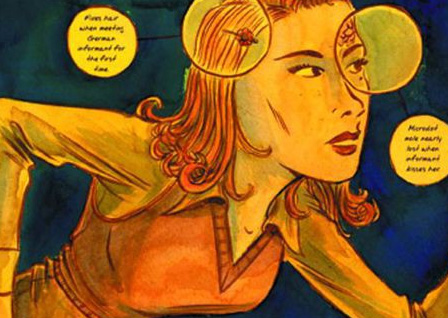
Super Spy
by Matt Kindt
336 pages
Published by Top Shelf
ISBN: 1891830961 (Amazon)
When I first approached Kindt’s book, I was not aware that he was weaving any sort of narrative tapestry. I thought Super Spy was merely a collection of short stories. It took the absorption of several stories before I came to realize that these stories were at all connected. It took several more to see that he was, through these disparate reflections, forging a single work. By book’s end, Kindt clearly and deftly presents his thesis: a portrait of the spy, a landscape of clandestine HUMINT.
Super Spy traverses the personal geography of the espionage circuit during the early-to-mid ’40s. Touching on all manner of occupational involvement (from state-trained agents to assassins for hire to citizens caught up in their national loyalties to those bound up in the war beneath the war due to coercions of one kind or another), Kindt’s book grants a broad perspective on just who might become involved in the game of secrets and how their experience would likely end up.
Several years ago I was doing research for a book I was intending to write. A book set in the world of spies and secrets. After reading fairly extensively in an encyclopedia devoted to espionage (both trade and history), my story gradually weaned away from being at all related to spies and nations and evolved into something else. Still, reading that much history of the craft leaves one with a certain perspective. Espionage is not glamourous. And more often than not, its practitioners come to bad ends. Espionage is, in reality, much more le Carré than it is Flemming. And Kindt’s work reflects this.
While certainly not all of his protagonists meet bitter conclusions, it is most often the case that their lives, if not destroyed physically by bullets, knives, or bombs, come to other tragic conclusions, twisted by sadness, loss, regret, or any other dozen of the psychological bugbears that plague those who traffic in lies and deceptions. Super Spy, while occasionally humourous (depending on the story), is generally a darker sort of work. It peers into the human spirit in a period of great distress. There is, after all, a war on—and wars have ever been the destroyers of souls.
1–1011–2021–3031–4041–50
51–6061–7071–8081–9091–100
101-200201-300301-500Afterword
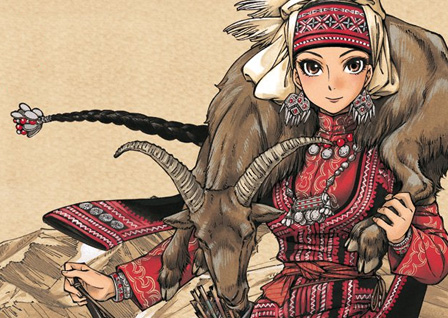
A Bride's Story
by Kaoru Mori (translated by William Flannagan, lettered by Abigail Blackman)
10+ vols
Published by Yen Press
ISBN: 0316180998 (Amazon)
In A Bride’s Story, Mori deposits the reader leagues away from the British romance of manners she crafted in Emma, instead exploring rural and nomadic life along the Western track of the Silk Road during it's diminishment in the Great Game era. While Mori has so far largely focused her attention specifically in what is probably central Kazakhstan, near the expanding Russian border and off a bit from what used to be the Aral Sea, she's been simultaneously following a narrative track that allows her to explore increasingly Muslim lands as she follows a character's trek around the Aral and south around the Caspian on his way to Ankara in Turkey. The cultures she describe are rich in a heritage and practice that will be largely unfamiliar to the average Western reader. This is a land of yurts, shepherds, big families, khanates, delicate carvings, intricate weavings, and ornate embroideries. Much of A Bride’s Story serves as educational documentary, explaining carefully the importance of these facets of the peoples the story concerns—and it’s a mark of Mori’s talents that these lessons are never dull. The story, while pausing its plot elements for a description of tribal politics or the importance of rug-hanging, is built and embellished and given life through these brief excursions.
The most obvious of the more unique aspects of the culture Mori explores in A Bride’s Story is this people’s tradition for youthful marriages. The author explains in her endnotes to the first volume that the average marrying couple in the region would have been fifteen to sixteen years of age. For dramatic purposes here, she adds and subtracts four years from the average for her principle couple—though in a subversion of the trope, the bride is twenty and the groom only twelve. This creates numerous opportunities for thoughtful consideration of how different cultures might deal with the man/woman dynamic—as well as plenty of related awkwardness for both reader and characters alike. Amir, the bride, is often torn between mothering her young husband, Karluk, and approaching him like a young woman who is gradually falling in love. Further adding to the dynamism of the work is the fact that at twenty years old, Amir is viewed by her society as an old maid and there is no small concern that Karluk may have been slighted by being given a wife who will likely bear him few children. Amir, therefore, is eager to please her husband and new family, which gives Mori ample opportunity to display the bride’s considerable talents. Amir hunts, herds sheep, embroiders, shows a talent at horsemanship to rival any of the men in the family, and has a good decorative sense.
A Bride’s Story offers contemporary readers a delightful opportunity to exercise the skill of reading and enjoying a text without finding moral agreement with the circumstances, actions, or particulars of its protagonists. For this reason, A Bride’s Story may even be desirable to get into the hands of younger readers (despite some occasional nudity—or substantial nudity once vol 7 rolls around since much of that volume occurs in a women's bath house) if for no other purpose than to promote this critical ability at an early age. Mori makes this an elementary text for this kind of exercise. Almost no American reader will approach the text thinking it good or appropriate that a grown woman should marry a boy who is only straddling the boundary between childhood and puberty—yet that is the circumstance this culture forces on its two very winning protagonists. Further, the reversal of the autumn-spring relationship trope presents opportunities to consider the contemporary sexual politic. As well, it’s interesting to see a situation in which a clearly competent, intelligent, and mature woman willingly places herself ultimately under the authority of a child (a kind child who evidently cares deeply for his new charge, but nonetheless…).

Boxers And Saints
by Gene Luen Yang (coloured by Lark Pien)
2 vols
Published by First Second
ISBN: 1596439246 (Amazon)
In Boxers & Saints, I find something beautiful that’s rather elusive in the bulk of religious works by religious folk. Boxers & Saints, while from the pen of a religious person (Yang is part of a Chinese Catholic community) and religious in nature (the books definitely work out of his faith structure), does not really feel like a religious work. Certainly we may acknowledge the parts in which Christian doctrine filters in and actually directs the books’ conclusion. And there are evidences of Yang’s personal eschatology at play, his sense of what becomes of the believer’s self after death. But the book plays so honestly with the faults and beliefs of its characters, Christian and pagan, that it just feels like an exercise in human observation—a riveting story of the condition of the species. Yang treats the Boxers with the same humanity with which he treats the saints.
To this end, Yang has intentionally created a work designed to interact with our sense of self by pushing us to understand the human story from multiple vantage points. We are ourselves. Simultaneously, we become Vibiana, who struggles to find balance between her heritage in a nation that despises her and a new heritage that proposes she sacrifice everything for the good of a new and heavenly nation. Simultaneously, we become Little Bao, who sees Christians and their foreignness as a very real threat to the goodness and sanctity of Chinese life. Simultaneously, we become Father Bey, a hardened priest whose frustration with the besetting sins of all who surround him drive him to feel betrayal at every turn. Simultaneously, we become Mei-wen, a woman who straddles the line between warrior-maiden and goddess of mercy and compassion. We are made victims and victors and victims again. Yang offers us a wealth of opportunities to see through eyes unclouded by hate. In a vision, the crucified Christ admonishes Vibiana to be mindful of others as he is of her. By proposing so many windows into so many souls, Yang fulfills his own Lord’s will somewhat, giving the reader the chance to inhabit the souls of others and learn to be mindful of them—a practice run for carrying the conviction into real life.
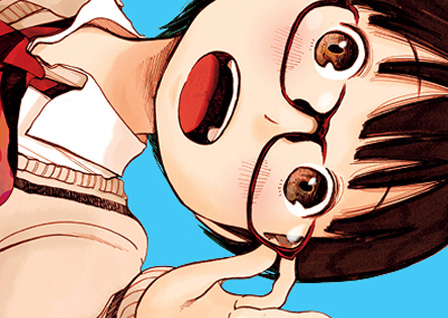
Dead Dead Demon's Dededede Destruction
by Inio Asano (translated by John Werry, lettered by Annaliese Christman)
6+ vols
Published by Viz
ISBN: 142159935X (Amazon)
In Asano's Dead Dead Demon's Dededede Destruction, he retains the wild cynicism that you'll readily find in his other works but spices it up with some lunatic humour. This is a book about catastrophic alien invasion and how, for the average citizen, that'd merely just be a minor hassle to ignore while continuing to work our ultimately meaningless jobs. It's a funny book and gorgeously drawn and Asano continues to poke at the bear of contemporary society and its values.
If you found Goodnight Punpun too brutal but still want to take part in the Asano conversation, Dededede is probably your entry point.
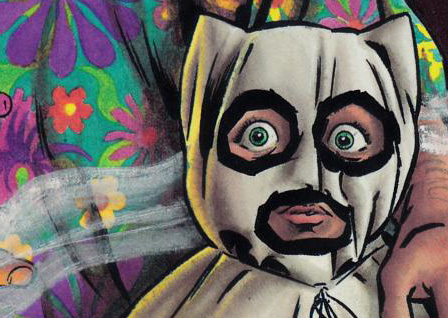
Stray Bullets
by David Lapham
Lots of vols
Published by Image
ISBN: 1607069474 (Amazon)
There are a lot of crime comics out there. Some of them are even good. Some are even great. But better than them all, better than Criminal, better than West Coast Blues (even if only marginally), is Stray Bullets.
David Lapham is a madman and that comes through in his crime stories in spades. These are brutal, madcap, depraved stories of what happens when people slough off the rules that govern polite society (which was never that polite to begin with).
Lapham covers a lot of ground across his series. A lot of time and a lot of characters. But he comes back to two leads over and over again: Virginia Applejack and Beth. Virginia is the most compelling of the two figures for me so I'm going to recommend starting with Stray Bullets: Killers. That's not the beginning of the series.
Lapham started Stray Bullets in the '90s and put out 40 chapters of the series before it became unsustainable work. There wasn't a lot of money in indie comics then (there generally still isn't today). The whole entire first run of the series is collected in Stray Bullets: Uber Alles, a phonebook omnibus collection. Then a couple years back, Lapham teamed up with Image to release new stories, to pick up where he left off. The first volume of these new stories is Stray Bullets: Killers, and it picks up with Virginia at age 17 or so after a lifetime's worth of horror has dogged her steps. It's a good place to start and if you like it, you can go back and read the earlier story.
Think of it like watching the original Star Wars trilogy only to find that the prequel series is as good or better than the original. What a world that would've been, eh?

The Amazing Screw-On Head
by Mike Mignola (coloured by Dave Stewart, lettered by Clem Robins)
104 pages
Published by Dark Horse
ISBN: 1595825010 (Amazon)
I had an inkling of Mike Mignola's sense of humour with the release of his delicious Hellboy-as-a-child story about pancakes (my wife and I will still announce to each other in appropriate circumstances, "He has tasted the pancake!"), but I wasn't remotely prepared for the pure madcap absurdity of The Amazing Screw-On Head. Mignola employs bizarre interactions, wacky characters, and pregnant pauses to brilliant effect. Part of the wonder of the humour is the surprise - and despite the fact that you know you're reading this zany, zany book, Mignola's delectable little moments still leap out from behind the curtains, startling in their ingenuity.
And of course, there's always the combined visual ferocity of of Mignola and Stewart. Which is just a lovely thing.
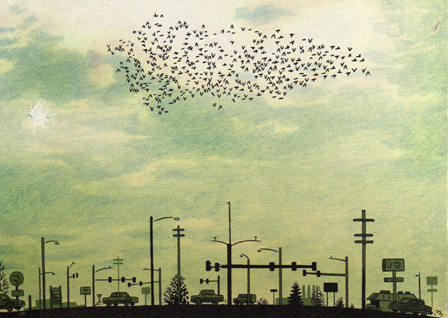
Curses
by Kevin Huizenga
144 pages
Published by Fantagraphics
ISBN: 1894937864 (Amazon)
Anthologies and short story collections are always such a difficult thing to judge. Generally the quality and value of the work is so varied that it's hard to come up with any kind of monolithic opinion to summarize the work. While single-author collections can be a bit easier, they still aren't wholly immune to this kind of trouble.
Kevin Huizenga's Curses is, for me, no exception to this rule.
While some of the stories are great and perfect examples of viable ways to use the comic medium to tell stories, others are merely good. Certainly, there are no bad stories found in this collection, but not everything is awestriking. Easily the best story in terms of sociological interest and storytelling chops is "Jeepers Jacobs," in which a golf acquaintance of protagonist Glenn Ganges ponders his responsibility for the state of Glenn's soul while penning an article on the doctrine of hell for a conservative evangelical journal of theology. I found myself very interested in Huizenga's ability to portray with sympathy both Jeepers' view of hell and his Christian responsibility and that of his colleagues with whom he sometimes strongly disagreed.
One of the more interesting stories visually was one of the least interesting in narrative terms. "Case 0003128-24" follows the expansion over about a hundred irregular panels of a sometimes impossible landscape, mimicking in pen-and-ink form the artistic style of Chinese brush paintings. In almost every case (there are a couple interesting divergences) the panels can be aligned to bring forth a single scene. And over this artistic expression, a narrative quoted directly from adoption paper plays out in captions. The effect is interesting and I'd love to explore it in more detail, but it wasn't the most invigorating read.
"Lost Boys" employs some narrative genius and makes the valuable use of the tools of the medium. Both subject matters treated are fascinating but I only partially think I understand Glenn's reaction (or punchline) at the tale's conclusion. "Green Tea" was an interesting exploration of a (fictional) historical incident. I didn't particularly care for "28th St," though it was an inventive enough retelling of another story and "Not Sleeping Together" was actually sometimes a chore to get through, though in the end it turned out to be worth the effort. "The Curse" may be the central story and its exploration of the Evil of the starling was fascinating and well rendered.
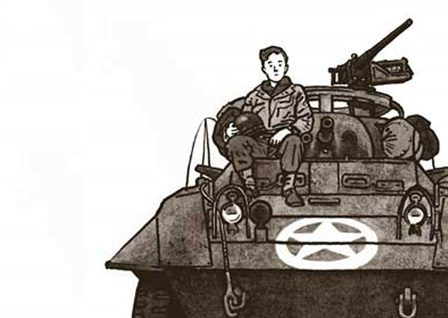
Alan's War: The Memories of G.I. Alan Cope
by Emmanuel Guibert (translated by Kathryn Pulver, lettered by Céline Merrien)
336 pages
First Second
ISBN: 1596430966 (Amazon)
In the book's concluding matter, Cope relates a little diversion about stories:
Pygmies have a tradition I like. They gather around a storyteller and yell out topics. For instance, when someone in the group says “Love!” the storyteller responds: “Love? It’s like this.” Or: “Hate? It’s like this.” And then he develops his story. You could call my story: “War? It’s like this.”
I suspect when Cope says “you could call my story…” he’s not speaking to the episode in which he went to Europe as part of an armoured car crew. Instead, he’s talking about his life. His life as a very particular kind of war story. It’s a good story and hits any number of the expected high and low beats. And readers will be able to exult in and live vicariously through a young man who for all his inexperience was something of a man of the world.
Cope’s stories are almost exclusively engaging and worth the time you’ll spend in reading them. And collapsed together into a single volume, they absolutely merit the couple to few hours it will cost to read them in their entirety. Cope’s life presents the reader with numerous points for self-realization and self-examination. It’s a good and thorough work and I enjoyed it immensely.

Blue Pills
by Frederik Peeters (translated by Anjali Singh)
192 pages
Published by Houghton Mifflin Harcourt
ISBN: 061882099X (Amazon)
What does it mean that every time you stick your penis into the person you love more than anything—an act you mean for pleasure and to give pleasure—you might be pulling the trigger on your own demise? What does it mean for the woman you’re with that every time you have sex, she might have accidentally killed you? What about this sweet little boy? How will he get through those awkward teen years? It’s hard enough to talk to girls you’re into when the culmination of your youthful horniness won’t kill them. And what if that kid doesn’t even survive to be a teenager? Nothing, after all, is certain. And the anger. At science, at fate, at friends, at society. At death. What do you do about the anger?
This is what Blue Pills is about. The stuff that often matters so much more than the summary of events that make up our lives (and deaths). And Peeters does a good job keeping this from feeling pedantic—even when by the end he’s strayed almost entirely into rumination. He keeps the book feeling real, feeling close, feeling intimate. And that’s why when we look into the kid’s bright wide eyes, we can’t help but romanticize. Because there’s magic there. A magic that Peeters, through art and through script, unveils. And Peeters could have done that thing that everybody does when telling a story about something tragic like HIV: he could have made it tragic. He could have pulled at hearts and strings. He could have cultivated pity and mournfulness in the reader, but that’s the last thing he wants. Blue Pills is not a sad story. And there’s magic in that too.
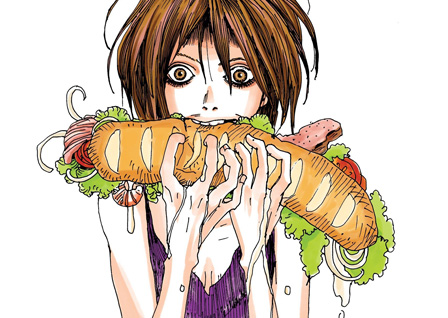
In Clothes Called Fat
by Moyoco Anno (no translator/letterer credited)
264 pages
Published by Vertical
ISBN: 1939130433 (Amazon)
Moyoco Anno’s In Clothes Called Fat intimately concerns a world maintained and partly governed by the sexual objectification of women and reads as a good companion to Kyoko Okazaki’s Helter Skelter. The book revolves wholly around how the principal identity of a woman is founded in her attractiveness. Every new chapter (save for the finale) is abstractly heralded by the depiction of a lean, beautiful, and often nude woman—who is not (until the last chapter) the protagonist. The entire ecosystem of Anno’s story is populated by an ethos and ethic developed around the desirability of women.
Noko is fat. She works in a business office, has a small taste of office social life, and keeps a handsome longterm boyfriend. But she is definitely fat. And while Anno’s portrayal of her obesity waxes and wanes, she is defined (and irrevocably so) by her weight. Early on, she deliciously describes herself: “It’s like I’m wearing a leotard of flesh that can never be removed.” Her position with regard to her social circle, female co-workers, boss, and boyfriend are all exactly circumscribed by the way she looks. She lives in a world where the sexual objectification of the female has run amok. That is, of course, to say: she lives in a world crisply reflective of our own.
I’m not certain of the intricacies of Japanese culture and how measured their reaction to an obese woman would be, but while the American reaction (probably) wouldn’t be outright bullying outside the cesspit interactions of YouTube and online forums, her measure as a woman would certainly be underlined and calcified by her weight. We value women in accord to their attractiveness. We believe that a woman can have use without looking good, but we’re more willing to believe her useful if she’s attractive. And then if she is attractive, we’re often more willing to forgive her inadequacies. In this manner, In Clothes Called Fat reflects even the American ideologies pretty well and should make for a fairly seamless read for the Western reader.
Anno delves into the experience and mystery of the culture’s fascination with beauty through unsparing episodes from Noko’s life. Her sex life, the bullying she experiences at work, her abortive attempts at self control. Noko is victimized by her own lack of self-confidence and her inability to truly grasp the manner of the world about her. A dietitian describes Noko: “Her soul is obese.” Anno allows the reader to dwell in Noko’s thoughts, giving us insight enough into the protagonist’s sense of the world and herself.
The principle conflict seems to be the question of whether Noko will be able to lose weight, thereby gaining confidence and a place in society, but Anno is canny enough to avoid a problem/solution pairing so pedestrian. Instead, In Clothes Called Fat wonders if it really is the clothes that make the man, postulating instead that no woman can successfully survive the ravaging of society and escape with her true self intact.
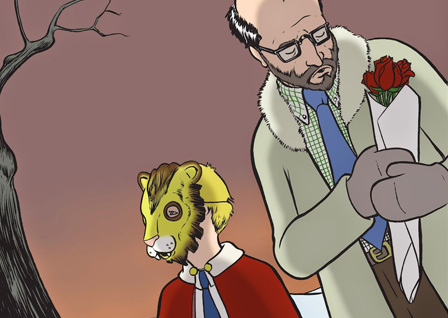
Mother Come Home
by Paul Hornschemeier
128 pages
Published by Fantagraphics
ISBN: 1560979739 (Amazon)
It won’t be revealing too much to say that Mother, Come Home deals with some heavy topics (as seen in figure 2, above). Told largely through the eyes of a child, the reader gets a rare sense of a very difficult set of extraordinary circumstances. Hornschemeier gradually unveils his narrative topography, controlling revelation in a way that should satisfy most readers, leaving them both affected by the story told and conscious that literature was absorbed.
One of Mother, Come home's great charms is Hornschemeier’s artwork throughout. His work is clean, uncluttered. I have seen more than one review compare him to Chris Ware, and while I cannot know how indebted the present author is to one of the obvious luminaries of the medium, common ground is aptly noted. Even beyond the book’s muted palette, which recalls Ware’s work in the nineteenth-century portion of Jimmy Corrigan, his panel focuses and strong linework evoke Ware’s own. And of course the submerged tone, hollow of emotion by its very flood of emotion, is also evocative of Jimmy Corrigan (which some may characterize as a stoic sort of work).
Mother, Come Home is a work deserving reflection. Hornschemeier has filled his pages with mysteries of life, some demanding interpretation, others commandeering their own liberty from such shackles.
1–1011–2021–3031–4041–50
51–6061–7071–8081–9091–100
101-200201-300301-500Afterword
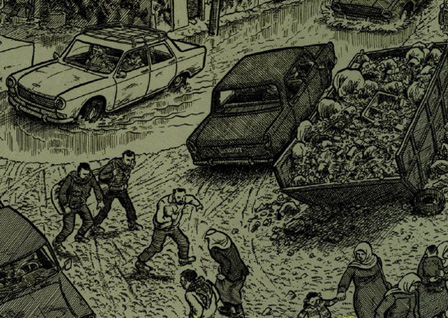
Palestine
by Joe Sacco
288 pages
Published by Fantagraphics
ISBN: 156097432X (Amazon)
Sacco is a special kind of journalist. Over the last fifteen years, he’s produced book after book giving readers an up-close perspective of areas of the world torn by the kind of traumas that Americans will likely never have to face. At least not in our generation. Maybe in the next if they are especially unlucky.
1999’s Palestine is a sprawling, 288-page non-fictional comic book that chronicles Sacco’s experience in Palestine at the tail end of the First Intifada (that is, the uprising of the Palestinian people against what they considered to be the oppressive Israeli regime—this lasted from 1987 through 1993). Sacco peppers his narrative with interview after interview, speaking to both Palestinians and Israelis, though spending more time on the Palestinian side of the equation. At one point he responds to a skeptical Israeli woman who wonders why he isn’t more interested in interviewing Israelis, telling the reader that he’s heard Israel’s side of things his entire life.

Exit Wounds
by Rutu Modan (translated by Noah Stollman)
168 pages
Published by Drawn & Quarterly
ISBN: 1897299834 (Amazon)
Modan's story about a Tel Aviv guy trying to find out if his philandering father died in a bombing in Hadera while traveling around interview people with his dad's 20-something-year-old girlfriend is simultaneously mystery and coming-of-age extravaganza. Who is the father? Who is the son? What does it all mean? Sounds pretentious maybe, but it's lifelike and well-wrought and Modan is one of the best creators of the last 20 years - so that's always nice.
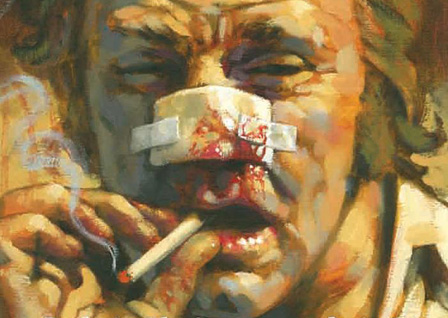
Criminal
by Ed Brubaker and Sean Phillips (coloured by Val Staples and Elizabeth Breitweiser)
7 vols
Published by Image
ISBN: 1632151707 (Amazon)
TEXT
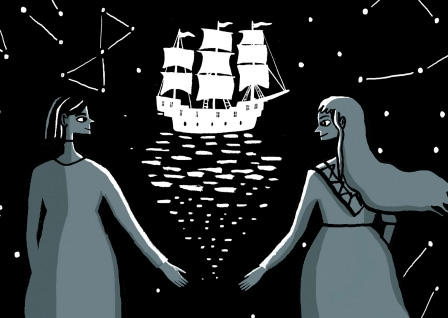
100 Nights Of Hero
by Isabel Greenberg
224 pages
Published by Little, Brown
ISBN: 0316259179 (Amazon)
The follow-up to Greenberg's Encyclopedia Of Early Earth, The One Hundred Nights Of Hero is lively and warm and takes a fierce sort of off-the-cuff joy relating one primary thesis: that there is both joy and power in Story. It's a perfect chaser to Early Earth but also stands well on its own.

Eartha
by Cathy Malkasian
256 pages
Published by Fantagraphics
ISBN: 1606999915 (Amazon)
Eartha is prodigiously imaginative and for something that has a moral in the same kind of way that the Gigantic Beard That Was Evil does, it never feels overly didactic or preachy. The illustrations are pretty too.
Eartha is a woman, guileless and strong and fat. She is everybody's favourite citizen of Echo Fjord, reliable and buoyant. Echo Fjord is an agrarian place where the dreams of the City come to visit (literally). The unfulfilled longings of the citizens of the City have for thousands of years migrated to the Fjord for catharsis and release. Only now, after a thousand years, few dreams arrive, and Eartha worries that everyone in the City has died from a war. Things happen and she goes to the city and more things happen and it's all pretty wonderful and the contrivances of the plot are pretty unebelievable but none of that matters because everything is pretty much just magic.
Lovely book. A bit large and unwieldy though. 12 in wide, 10 in tall, an inch thick and hardcover. It doesn't fit right on my bookcase so I have to tilt it 90° so the spine is facing up instead of out.
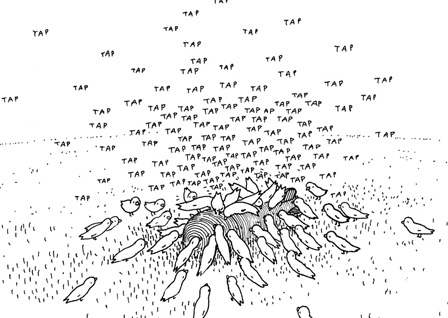
Big Questions
by Anders Nilsen
658 pages
Published by Drawn & Quarterly
ISBN: 1770460470 (Amazon)
Big Questions is a curious animal of a book. Its method of gradual production threatens the sense that Nilsen knew what he was doing all along or that the book can be read as a single cohesive work. Nilsen, as he explains in the book’s backmatter, began collecting the occasional one-page scraps of talking-bird cartoons he’d been producing for years. Almost accidentally, it seemed, a narrative began to form around these sometimes thoughtful finches. And then at last, the addition of arbitrary violence from the American military machine set in motion a grand tale spanning a milieu approximately the size of a sprawling backyard.
Still, Nilsen’s production here shines even while it remains unclear how much stock we’re meant to place in the book’s place as single multi-threaded narrative (vs. that of intersecting anthology of incidents and stories). Despite the book’s leisurely stroll through its story parts and Nilsen’s often sparse storytelling, Big Questions ends up feeling a very full meal. There’s a lot to think about and Nilsen’s penchant for leaving his Big Questions often unanswered lends to its position as a Thoughtful Comic. (If it weren’t for the book’s $45 price tag, it’d almost certainly become a regular subject of graphic-novel–leaning book clubs.)
While there is a plot to Big Questions, plot doesn’t necessarily drive the work. There are things that happen to prompt the characters to their various means and ends, but those events and the motivational vectors they produce are always secondary to the discussions (verbal and otherwise) they generate. Big Questions is a book about questions, a book about how to arrive at or depart from ideologies. Across the simple storyscape of these birds and their simple lives, Nilsen draws out a number of parables to ask simple questions about our own existence. Sometimes the circumstances or questions might seem too simple, but even then, the opportunity for thoughtfulness blossoms.
It’s a big book and a good book and one that, despite occasional clumsiness, provokes thoughtful critique and critical thought. What exactly Nilsen’s game is might not ever be made clear, but maybe it doesn’t matter. Maybe some books are there less for what they say and more for what they ask.
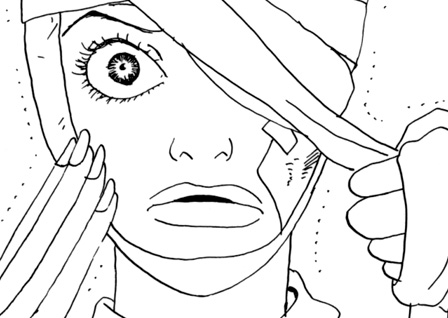
Helter Skelter
by Kyoko Okazaki (no translator/letterer credited)
320 pages
Published by Vertical
ISBN: 1935654837 (Amazon)
Before she was left pretty much completely debilitated in a car accident in the '90s, Kyoko Okazaki was sending up delicious, brutal, and incisive satirical culture-critique via the comics medium. Her stuff is raw and disarming.
Helter Skelter tells a tale reminiscent of Sunset Boulevard (and even straight-up references the Billy Wilder film) and prescient of Moyoco Anno’s Sakuran. Actually, it probably plays avatar for the million other stories about women whose usefulness is predicated on their sexual beauty and the desperation with which they fear the abolition of such a temporary celebrity. Not only do such heroes of the popular culture have to contend with the constant fickleness of a populace whose tastes bend and twist on a dime, but terror of the inconstancy of the masses is bolstered by the model’s knowledge that age weathers all and that she only ever had a dwindling, minuscule shelf-life. In Liliko’s case, her terror is accelerated by a brute fact of the procedures she used to mold her body into a physical perfection—while drugs and treatments may temporarily slow the degradation, her flesh will begin eroding at a terrifying rate. And more than just aging dramatically, women who’ve undergone similar treatments show seeping lesions, deep bruises, and corrosion of the material beneath the flesh. These women become monsters, and monstrosity is Liliko’s certain future—so she’ll see if she can’t get a jump start on it.
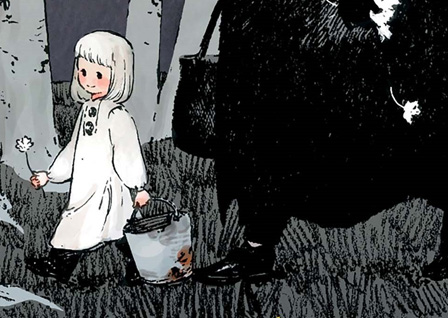
The Girl From the Other Side: Siúil, A Rún
by Nagame (translated by Adrienne Beck, lettered by Lys Blakeslee)
5+ vols
Published by Seven Seas
ISBN: 1626924678 (Amazon)
It bums me out that this series isn't complete, in the can, and on my shelves, because I want them all—because so far this series is straight magic. It's beautiful, spare, touching, and imaginative. It doesn't overplay its hand and it's a haunting delight.
Basically, there's this little girl who was left behind outside the city walls where the cursed outsiders dwell. Being touched by an outsider means that you too will be cursed and will turn black and grow horns like they do. Only this little girl lives in a small cottage with one of the outsiders who is bent on protecting her and teaching her. He looks like a monster but he worries about telling her the truth about how she was left behind by the Auntie whose return she eagerly awaits. There is the mystery and the politic, but at the end of the day, this is about a little girl in a dark world.

Swallow Me Whole
by Nate Powell
216 pages
Published by Top Shelf
ISBN: 1603090339 (Amazon)
It’s almost cliche at this point to praise Nate Powell’s Swallow Me Whole, but it’s not like there’s any honest alternative. The book is just too good for anything else. Talented illustrator? Check. Talented storyteller? Check. Imaginative? Funny? Insightful? Worthwhile? All systems are go. Powell’s art reminds me of some delicate hybrid between Craig Thompson and David Lapham—and amusingly, Swallow Me Whole is like some strange cross-pollination between Blankets and Silverfish.
Okay, well not really. But kinda.
Swallow Me Whole works to cement the place of comics as a vessel through which the mentally well (whatever that may mean) might come to better understand the mentally unwell (whatever that may mean). My experience with those suffering under the fist of schizophrenia is limited to a relative I’ll never know, so I can’t speak very well to the accuracies of Powell’s depiction save to say that it isn’t so far from the stories I’ve been told by my relatives— relatives who survived the terror and oppression this one errant family member brought into the family by her delusions.
Often these illnesses are portrayed from the outside, from the viewpoint of a quote-unquote neutral observer. Powell gets to the heart of things by giving us two protagonists, Ruth and Perry (one medicated and one not), who labour under the grip of delusions that they recognize to be delusions yet still have no recourse but to answer to these illusions’ demands. What’s better is that we are allowed to experience their hallucinations somewhat as they experience them. Ruth’s delusions are more interruptive and she embraces them with less hesitation, but Perry’s can be no less intrusive and no less compulsive.
Where Swallow Me Whole’s real strength lies is in the fact that Ruth and Perry talk openly between themselves about the trials of their own branded delusions. Powell goes to pains to give breadth of soul to other family members despite offering them strictly limited screentime but the real focus is Ruth and Perry. Even though neither has any experience of the other’s hallucinations (Ruth’s feature ambassadors from the insect kingdom and require a shrine of physical corpses while Perry’s involve a diminutive wizard who resides primarily on the end of his pencil and forces him on drawing missions), they speak to each other with love and understanding. Even as the difficulties of their lives threaten to destroy them and their family, they have each other to hold onto and it seems only by their bond that they’ve survived as long as they have. These are two deeply involving and sympathetic characters who carry the book on the shoulders of their interactions with each other.
The book’s conclusion is going to be the sticking point for most readers, either confusing them into distrusting the book or elevating it to a work of grand accomplishment. I fall into the latter of these two artificially-constructed catchall bins. There are, I think two valid interpretations for the finale. Both of which are powerful and amazing. I’m not sure which reading I prefer—each has its merits—but in the final analysis, each shows the horrible power of this kind of condition and how acts of coping on one’s part can destroy the lives of others. The climax is amazing and, whether taken literally or figuratively, demonstrates well Powell’s grasp of the material. Great stuff!
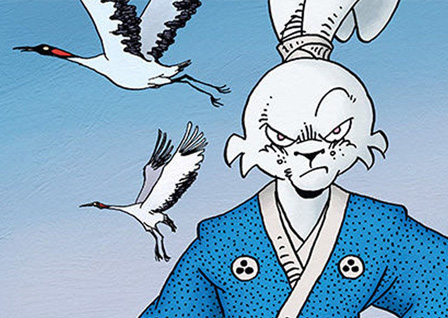
Usagi Yojimbo
by Stan Sakai
30+ vols
Published by Fantagraphics/Dark Horse
ISBN: 1616553987(Amazon)
Usagi Yojimbo is the story of a fictional, idealized, totemic, and somewhat historical Japan. It is a story told by following (primarily) a single wandering ronin as he follows the way of the samurai, seeking enlightenment, honour, justice, and the beauty of living. Due to his wandering nature, the reader encounters a breadth of stories, regions, and cultures. These tales unfold circa 1627 and create, despite their (sometimes) almost mythical hue, a worthwhile vantage into real and historical Japan.
Sakai peppers his narrative with the fruit of a lot of research. The most popular of his stories, “Grasscutter,” begins with a lengthy-though-entertaining excursus into the mythological origins of Japan and her people. A shorter story, “Daisho,” explains the craft with which the samurai’s sword-pair is forged and the importance those two swords (called daisho) hold to their owners. Other chapters include overtly educational bits on kite-making, pottery-making, and the intrusion of the West into the Far East. And even when he isn’t completely halting his telling in order to instruct the reader, Sakai weaves a story that posits a seamless, discreet form of education—taking part in the story by simply reading it, Sakai’s audience is constantly learning more and more about a dead and foreign culture.
One of Sakai’s great talents is in his visual storytelling. His art flows naturally and his panel design is masterful. Some of the most beautiful pages are silent and filled with panels; each of these panels illustrates part of a picture-story that initially seems unrelated to the narrative intent but ends up providing context or mood for everything that is to follow. Sakai’s art has a wonderful, lyrical quality to it and it’s incredible that he’s been able to maintain his more-than-twenty-five-year schedule of producing one chapter per month. He really is one of the best creators in the medium.
30 vols is a lot to take in. If you want a nice place to start, to see if this is a book for you, I'd recommend read vol 28, then 29, then 30 and backtracking from there if the story suits your tastes.
1–1011–2021–3031–4041–50
51–6061–7071–8081–9091–100
101-200201-300301-500Afterword
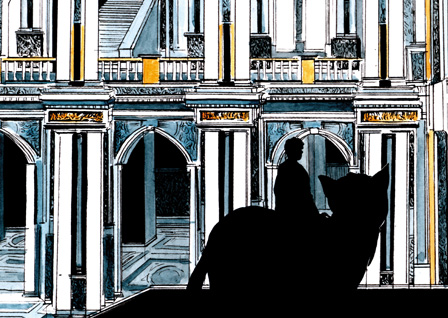
The End Of Summer
by Tillie Walden
88 pages
Published by Avery Hill
ISBN: 1910395137 (Amazon)
So there's this family that's super wealthy. And they live in a place where winter is 3 years long and kills everything that's not sealed up and warm. And three years is a long time to wander around even a magnificently large house.
The End Of Summer is basically about Lars, who with his twin sister Maya, is one of seven children of a fabulously wealthy family in just such a place and at just such a time. Their house is cavernous and ornate and amazing. Lars is sick with a sickness that means he won't last the three years. His family knows he's sick but doesn't know this is the end for him. He also rides around on a gigantic cat named Nemo because he'll get too winded otherwise. Lars isn't the only one in trouble though and as I said, three years is an awfully long time to be cooped up.
Walden's illustrations are a dream and she tells a story that takes in the architecture of the place every bit as much as it does the architecture of this family and their interrelationships. It's a quiet work punctuated by moments of human terror. It is worth your attention.
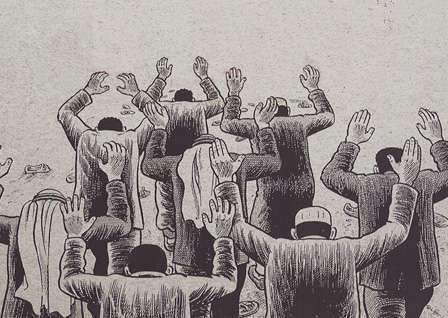
Footnotes In Gaza
by Joe Sacco
432 pages
Published by Metropolitan
ISBN: 0805073477 (Amazon)
After several excellent journalistic comics featuring the Bosnian war and its aftermath, Sacco returns once more to the Palestinian conflict. And this time he has a far more specific goal in mind. Footnotes in Gaza, at 432 lushly illustrated pages, offers a new avenue for Americans who support Israel unreservedly to experience a paradigm shift and the opportunity to experience the conflict from the eyes of those who hold a perspective unique from anything we could ever muster on our own.
In Footnotes, Sacco splits time between present-day Gaza (that is, 2003—these things take a long time to draw) and Gaza in 1956 where he hopes to unveil the truth behind two massacres the Israelis purportedly carried out against Palestinian civilians at the end of the Suez Crisis. In the present day, Sacco moves from contact to contact with his guide and advisor, Abed, as they seek out anyone who lived through the terrible events. Along the way, Sacco treats subjects as various as the mindset of insurgents, the demolition of Palestinian homes at the edge of the refugee camps, the sheer mass of poverty these people experience, Palestinian reaction to American interventionism, and (briefly) the death of Rachel Corrie.
As he slowly unveils what happened and what may have happened (Sacco is at all times circumspect about the fact that his interviewees are all very old and that their stories oftentimes conflict), we’re given a sense of just how desperate the situation is—not for the region but for the people. What is so often lost in the news reports we hear from Gaza is that these terrible circumstances are not just part of a larger political struggle and the ways of nations, but that these horrors are the fabric from which individual human lives are cut. If not for the hand of a fate that we can neither predict nor understand, that could be my mother whose leg was blown off in the most recent shelling. That could be my daughter who was killed in a Palestinian incursion. That could be my home being demolished suddenly for no better reason than that it provides decent cover for potential insurrectionists.
In Footnotes, Sacco proves that he is becoming better and better at what he does. Prior books Palestine and Safe Area: Gorazde are both fantastic treatments of their unique subjects, but with his present work, Sacco shows a lot of narrative growth. The book is hard and unrelenting and funny and insightful—and the way Sacco threads the whole thing together speaks to the fact that he is becoming a master at the craft.

Beauty
by Hubert and Kerascoët (translated by Joe Johnson, lettered by Ortho)
144 pages
Published by NBM
ISBN: 1561638943 (Amazon)
Coddie is the ugly daughter of a fish scullion. She stinks of fish because of handling them day-in and -out for years on end. She holds no hope for her future and is routinely abused because she is so ugly. Rescuing a trapped faery one day gives her one wish. She wishes for beauty and while the faery cannot change her physical nature, it alters perception around her so that all perceive her to be the most beautiful, most attractive, most alluring woman in all of creation. This basically just makes men go crazy around her. (Brubaker tilled similar ground in Fatale, though Beauty takes it in another direction.) Superb illustrations from Kerascoët, as per usual.

Pluto
by Naoki Urasawa adapting Osamu Tezuka (co-authored by Takashi Nagasaki, translated by Jared Cook and Frederick L. Schodt, lettered by James Gaubatz)
8 vols
Published by Viz
ISBN: 1421519186 (Amazon)
Pluto is foremost the story of the murders of several robotic AIs. These artificial intelligences struggle with balancing their self-awareness with the shackles of their programming. In a way, Urasawa may even be trying to tackle, in some remedial way, questions of liberty vs determinism—something all those with any interest in metaphysics must come up against at one point or another. From another angle, these robots’ lives spell out the same conflict that MT Anderson homes in on in his wonderful Astonishing Life of Octavian Nothing: the question of liberty and property; how can those who rally behind freedom, democracy, and liberty keep sentient beings as property.
Where Urasawa excels so ably is in making his robotic characters so human, so other-than-human, and so worthy of compassion in either case. There are moments for several of these robots (whose narrative destiny, set in stone fifty years ago by Tezuka himself, is to be destroyed) at which the average reader may very well need to take a moment to regain composure. We are never not aware of these characters’ non-human status and the fact that they are creations of man, but all the same they become valuable recipients of our cares and well-wishes.
And it is through that marvelous narrative inducement toward empathy that Urasawa sells his point home. He requires the reader to consider the what-ifs of his scenario. Ignoring plausibility for a moment, he not only raises the question of artificial personhood but also gives the reader a reason to care about that question. Adam Hines attempted something similar in Duncan the Wonder Dog, by actually giving personhood to animals; but as much as I laud Duncan as probably the pre-eminent work of comics fiction, I believe Urasawa pulls this particular thing off much more adeptly.2 It’s difficult to balance the humanity and inhumanity of these characters in a way that makes them both comfortable and alien, but Urasawa succeeds. Pluto, against odds, is neither too heady nor too treacle nor even too plot-driven. And for a book structured as a detective thriller, that’s some achievement.
Pluto is only eight volumes long and is therefore much more tightly plotted than either Monster (18 vols.) or 20th Century Boys (24 vols). It’s a good read and gives the reader opportunity to think about a number of fascinating subjects, all while carrying on a murder mystery/thriller. For a series that (at its most basic and dumbed down) is a book about a series of robot fights, Urasawa wisely shows very little actual robot-on-robot combat. He knows what’s interesting and fighting robots is not quite that. Pluto is an investigation of emergent technologies, an investigation of the toll of contemporary international policies, and an investigation of the nature of the soul.
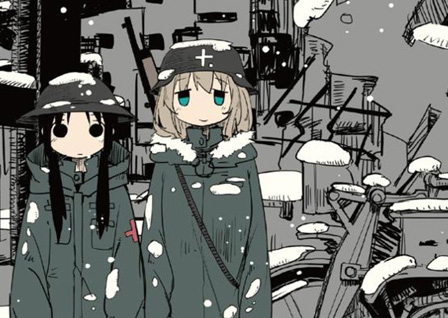
Girls' Last Tour
by Tsukumizu (translated by Amanda Haley, lettered by Abagail Blackman/Xian Michele Lee)
6 vols
Published by Yen Press
ISBN: 0316470627 (Amazon)
Tsukumizu's GIRLS' LAST TOUR is a wonderful book. Cute, thoughtful, morbid, and filled with humanity. It's about two teenagers, Chito and Yuuri, who ride around the post-war ruins of civilization on their halftrack both trying to pass the time and trying to survive. The need food, water, shelter, and fuel, and as they putter around acquiring these, they chat about stuff. What music is, what god is, why people go to war, what's worthwhile, what cheese is. Stuff like that. They need each other and while they're very different in personality and interests and intelligence and ability, they are pretty much all they have. There're not really any other people around. One here, one there, but food is scarce and so is the will to keep living. One person they meet hasn't seen anyone in so long that he starts choking when he tries to use his voice.
Despite the brevity and abortive nature of the girls' forays into the philosophical, their conversations are lent gravitas by their context. It's a kind of shorthand that works really well. Then there are these pretty out-of-the-blue moments of sublimity that can strike in such a way that beauty and thoughtfulness transcend the page and threaten to make the readers exterior life more beautiful as well. It's a good book that tries to deal with hopelessness in a manner that is warm, cozy, and not entirely depressing - even if it can't avoid it entirely.
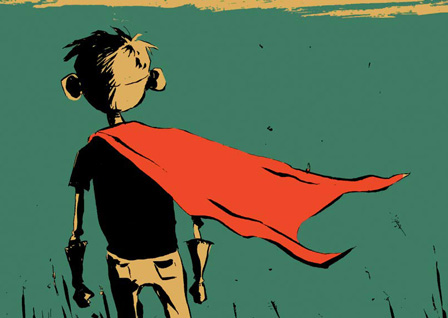
Essex County
by Jeff Lemire
512 pages
Published by Top Shelf
ISBN: 160309038X (Amazon)
Originally three volumes, the Essex County trilogy is combined into a single large volume and, so far as I am concerned, is the best of Jeff Lemire's work. He does a lot of things in sci-fi realms as well, but for my money, Lemire is at his best when traipsing through the scattershot lives of the mundane and everyday, with no hint of space exploration or time travel or super powers or AIs. Just the emotionally destitute, the downtrodden, those who don't merit for much their inclusion in society. The kind of people our Statue Of Liberty used to welcome (and on a particularly idealistic day, may still). Lemire gives such characters life and weight and the kind of substance that we should hope from all of our fictional spirits.

Alias
by Brian Michael Bendis and Michael Gaydos (colours by Matt Hollingsworth, letters by Richard Starkings et al)
4 vols (or 1 omnibus)
Published by Marvel
ISBN: 0785198555 (Amazon)
This is probably in my Top 5 Marvel runs of all time. I have loved Bendis on 4 books and this one is pretty magnificent.
The big idea is that Jessica Jones (whom you may know from Netflix) is a former superhero and Avenger hopeful (it really really didn't work out) who now runs a detective agency, Alias Investigations (hence the title). Each arc is her getting these dark cases, which (almost) inetivibly tie into the Marvel Universe, usually in some fringe way—until the big finale, (which Netflix adapted).
Bendis cut his teeth on crime comics and his love for the genre shows through here. Also, through Jessica's distance from it, he kind of redeems the Marvelness of the Marvel universe. Michael Gaydos is on art for the book's duration and does a great job playing with Bendis tropes while simultaneously giving the book a visually distinct look that, again, distances it from the Marvel universe.
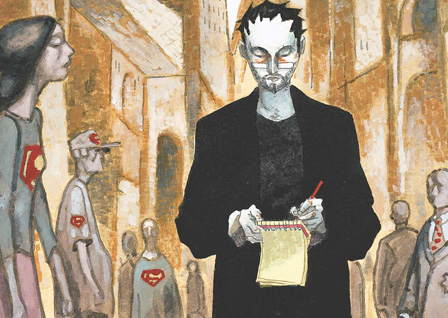
It's A Bird
by Steven T. Seagle and Teddy Kristiansen
136 pages
Published by DC
ISBN: 1401203116 (Amazon)
This is kind of a Superman book but not really at all. But then again, kind of. It's about Seagle (the writer) being offered the chance to write Superman by the overlords at DC. He's conflicted because of associations with the family's genetic secret: Huntington's lurking in the background. It's a book about hope and anger and terror and resolution - and finding meaning in a life that's full of traps and hidden miseries.
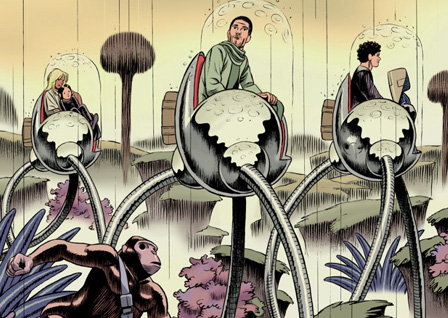
Aama
by Frederik Peeters (translated by Edward Gauvin)
4 vols
Published by SelfMadeHero
ISBN: 1906838739 (Amazon)
What begins as an excursion to an alien planet to get Verloc's mind off his failed marriage and restraining order preventing him from seeing the mute daughter who is his light and life turns into a terrifying adventure and eventually an expansive extrapolation into the evolution of the species and what a forced renegotiation of the nature of the human consciousness might look like.
Peeters is firing on all cylinders both as a writer and as an artist. Four short volumes round out what is one of the best sci-fi stories in the comics form.

March
by Rep John Lewis, Andrew Aydin, and Nate Powell
3 vols
Published by Top Shelf
ISBN: 1603093001 (Amazon)
Powell, as usual, is on fire here. His art—both the staging and the linework itself—is perfect. A co-worker who doesn’t read comics walked by as I had the volume open and without knowing what I was looking at remarked: “That’s beautiful.” He was right. The book is printed in black and white, with grey washes for shading, and the work is great. The desaturation evokes old television or photography and moves the reader into the past. The washes give the illustrations an easy flow and blend, helping the reader wade into an atmosphere and time to which many would otherwise struggle to adjust. Powell draws us into John Lewis’ story—into his life—without effort.And it’s a pretty tremendously interesting life.
Congressman Lewis participated in the 1963 civil rights march on Washington DC. He was the youngest speaker at an event that is mostly widely remembered for Dr. King’s “I Have a Dream.” March is the story of the March On Washington (and really of the whole Civil Rights Movement), told as memoir from John Lewis himself. Book one doesn’t ever arrive at even the beginning of the march, instead spending its time exploring the childhood and young adulthood of Representative Lewis. In approaching the story obliquely and wholly as prologue, March gives readers a sense of place—a foothold into what may otherwise be a largely alien landscape. We see young John and his family making a living in rural Alabama. We see the strict rules that governed the ways they could interact with the world around them. We see young John’s thirst for justice and righteousness. We see John take up the role of preacher, and we see his burgeoning interest in liberation theology and the social gospel. And we see the early sparks that lit the conflagration of the civil rights movement—that would burn away so much of the accumulated ethical detritus that dirtied America from sea to shining sea. It was to be a holy, sanctifying fire—a movement that could be a seraphamic coal to America’s tongue, if only the nation would stand up and say, “Here I am!”
1–1011–2021–3031–4041–50
51–6061–7071–8081–9091–100
101-200201-300301-500Afterword
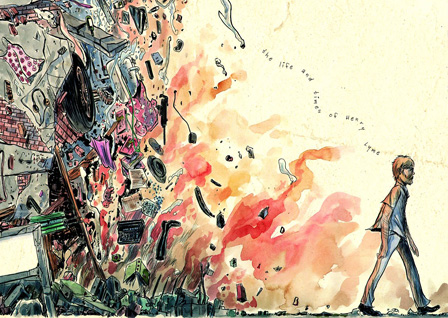
Mind MGMT
by Matt Kindt
6 vols
Published by Dark Horse
ISBN: 1616557982 (Amazon)
Mind MGMT is kind of a cross between post-Cold War spy novel and X-Men. The raw corners of the world are bursting with men and women and boys and girls who develop extrasensory powers of a variety of motifs. The propagandists who write or draw or sing utterly convincing ideas into life—some even possess the ability to write the equivalent of Monty Python's fatal funniest joke of all time. Others are precogs, others speak with animals, others cause amnesia, others cast illusions. And others' minds are so dominant that they cannot be killed, their minds won't let their bodies believe in their own demise.
And shadowy organization MIND MGMT is collecting these individuals to do the good work, the great work. Verr hush hush, verr political. And then there's the opposition organization, probably the Russians. Or there was. All that was over well before the start of the book. the Management turned out not to work. Or it worked too well. Or something. That's all part of the mystery. But anyway, someone's trying to start up the Management again and Meru keeps forgetting things and what is up with that and why can't she finish her second book? Mind MGMT is about a lot of things and it's got a lot of moving pieces and you just kind of have to stay along for the ride and be willing to renegotiate what you know on the fly.
A while back, I described the way I see Kindt as a creator: "Kindt strikes me as foremost an Idea Man. Everything he’s shown us so far paints him as prodigiously imaginative. He has big ideas for his overarching story, for the forms those stories take, and for the intricacies of how his pages and panels will lay out. I don’t look for any improvement on his part in this area. He has, so far as I’m concerned, arrived. If not perfect for what he’s doing, his ideas are close enough that we mere mortals cannot distinguish well enough to complain."
Mind MGMT does nothing to offer counter-argument to this conception of its creator. Kindt does show himself to be again prodigiously imaginative—and perhaps still moreso than in prior works. His attention to the intricacies of both his plot and the world he’s built for it to play out in is stunning. It’s hard not to sit slack-jawed and self-defeated when one comes across so sure-footed and designed a story as what Kindt regularly produces. It’s smart without ever passing into heady. It’s fantastic without breaking the conventions of believability.
When I was in college, Mind MGMT would have blown my mind. The highest compliment I can pay it is to affirm that Mind MGMT blows my mind today, twenty-five years after my freshman year of college.
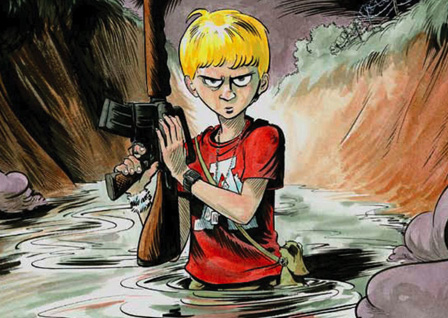
Any Empire
by Nate Powell
304 pages
Published by Top Shelf
ISBN: 1603090770 (Amazon)
Any Empire is an exploration of the essentially violent worlds that many of us have grown into. Powell’s male lead, Lee, grows up in the late ’80s or early ’90s reading Larry Hama’s G.I. Joe and imagining his town a war zone. Visually, Powell projects these imaginations and visions into real space, showing how strongly they exert their force upon Lee’s interpretation of the world around him. Similar forces play on the perspective of Lee’s neighbour, Purdy. An insecure child, both bully and bullied, Purdy is at odds with a world that he cannot understand, a world that doesn’t care to be understood by him. He’s not quite a bad guy, but he’s not good enough not to be. He too lives in a militaristic imagination and even during his childhood, the reader sees that he is a bit unhinged from any sort of plausible take on reality.
It’s as Powell follows these two through their lives into young adulthood that we see how their affections for the implements of war have impacted their lives. Powell creates a couple worthwhile lessons here, but even if those are his main point, he doesn’t seem to feel any need to belabour them. Powell says his piece through several moments and leaves the story to unfold itself.
He definitely has things to say both about our culture of violence and the human affection for war, but Powell spends time on the healing side of our nature as well. Any Empire's female lead, Sarah, cares deeply for animal life and goes to great lengths to secure the welfare of any injured creature she discovers. Just as Lee lives in a world propped up by G.I. Joe, the clockworks of Sarah’s world grinds under the direction of Nancy Drew mysteries. And these affections follow her into adulthood. While as a child, she investigated the abuse of the local turtle population by a gang of ruthless children, as an adult she makes investigative housecalls for child services. Both are thankless jobs, but she pursues them because it was in her nature to do so.
It’s Sarah and her mom who drive home the lesson that not all people are such as those described in 1939’s classic animated short, Peace on Earth—a powerful, anti-war piece that Powell uses to good effect in one of the book’s more poignant scenes. In Peace on Earth and its 1955 remake, Good Will to Men, some animated squirrel children (or mice in the remake) ask an older animal what men are, referencing the lyric “Peace on earth, good will to men.” The grandfather figure explains how men were terrible creatures, bent on destruction, and how even when there were only two left, those two still ended up killing each other. It’s a fearsome picture and I recall vividly the first time I saw Peace on Earth as a child. Powell uses this story to lead into a powerful moment between Lee and his father, but it’s seeing Sarah live out a life counter the film’s example that really sells the idea.
Powell continues to show himself a creator who is absolutely worth paying attention to and Any Empire may even be better than Swallow Me Whole, which was sublime. The great thing about these books (I mean, beyond the stellar art) is how well they stand up to multiple reads. Powell crafts a rich tapestry of both visual and narratory tricks that serve to inject subsequent investigations with a freshness and interpretive excitement.
Note: In a pretty wild display of my country’s militarism, the US Marine Corps ran some close to full-scale training exercises in actual American cities. Dayton. Birmingham. Boise. In order to simulate for soldiers the difficulties involved in urban warfare, the marines were tasked to carry their training, complete with helicopter drops and in some cases live ammunition, through the civilian streets. At least in some cases, areas were cordoned off in an effort to protect citizens from, well, injury and death. In others, city-dwellers were given the opportunity to play a part in these exercises. Some saw these events in a dim light and really, for the already mistrustful public, what does it say when a nation’s military practices invading its own cities?
That’s probably neither here nor there so far as concerns Any Empire. Probably. But let it be known that until after I finished the book the first time and did some poking around, I had no idea that this sort of thing happened. And that ignorance cost me a perfectly enjoyable experience on my first read-through. I had gotten to this point in the last third of the book and I was just completely baffled, thinking that Powell had without enough warning taken readers into the same surreal territory as he had in Swallow Me Whole. (If you’ve forgotten Swallow Me Whole, the male protagonist talks to a wizard the size of his fist and the female lead becomes the Queen of Insects.)
But see, he hadn’t. I didn’t know it at the time, but Powell’s final act is largely literal. Based-on-true-events kind of stuff. Certainly there’s a bit of subjective magical reality going on, but the military stuff that happens there at the end? It happens.
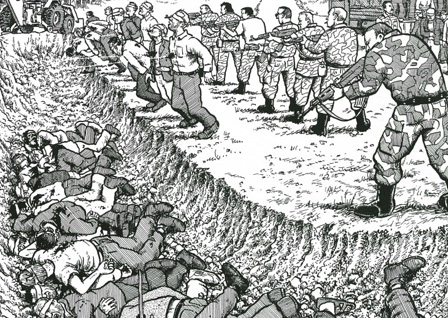
Safe Area Gorazde
by Joe Sacco
240 pages
Published by Fantagraphics
ISBN: 1560974702 (Amazon)
Honestly, I haven't read this in 15 years. Sacco isn't the type of work I go back and reread over and again. Especially now that the Bosnian/Serbian cataclysm is so distant. Last time I read this I was, appropriately enough riding around Eastern Europe on a train. The kind where when you poop, it goes straight onto the tracks below you. Closest I got to Serbia though was the Continental Hotel in Severin, right across the Danube from Serbia. Anyway, though I haven't read the book in long enough that the particulars have gone fuzzy, I do remember the impact. Sacco's interview style is forceful and builds empathy naturally. Before I finish this list later this week I'd like to reread Sacco's immediate follow-up to Safe Area Gorazde, The Fixer. As I remember, its more focused subject matter was compelling.
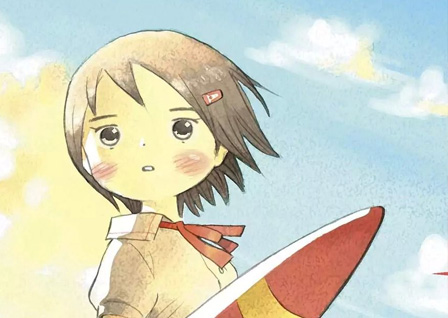
Twin Spica
by Kou Yaginuma (translated by Maya Rosewood)
12 vols
Published by Vertical
ISBN: 1934287849 (Amazon)
There is this fine line, razor thin actually, between the base manipulation of a reader and the generation of emotional impact through honest means. You might not believe it exists and you’d be right to be skeptical. Books that straddle the line are rarer than books that praise the literary structure and depth of Stephenie Meyer novels. Or maybe not that rare. But still, pretty rare.
The thing is: most books that call out to the passions either a) do so quite honestly and work hard to elicit their response through genuine means or b) are contrived pieces of brute violence whose whole identity lies in the ability to wrench tears from the reader. There’s not a lot of writing out there that makes you wonder which side of the fence a book comes down on. It isn’t often that I’ll actually need to have a conversation with myself about whether or not a book earned its response from me.
Twin Spica is a book that plays against expectation, then.
Twin Spica composes so grand a wealth of emotive moments that if a reader is at all averse to misting up within sight of others, the book should not at all be consumed in public places. I typically have ended up reading each volume on lunch breaks in coffee shops or pizza parlours and every last time I’ve been stuck staring at a page waiting for the lines to stop being so damned fuzzy and regain their composure. It’d probably be embarrassing if I at all cared what dining strangers thought of the thirty-seven-year-old man biting his lip and reading manga in a booth by himself.
So yeah, Twin Spica delivers the emotionally devastating moments so frequently and with such apparent abandon that even though the book feels honest, I can’t help but remain skeptical. Could any book so frequently and so convincingly bring me to be whelmed with feeling without resorting to fakery? I mean, I don’t feel manipulated, not really. But maybe Yaginuma is really just tricking me with his winning characters and their lives built on hope and pain and their willingness to take on a world that’s clearly too real for their dreams.
The thing is: I don’t care.
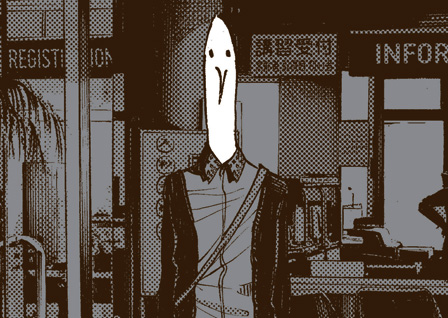
Goodnight Punpun
by Inio Asano (translated by JN Productions, Annaliese Christman)
7 vols
Published by Viz
ISBN: 1421586207 (Amazon)
Goodnight Punpun is one of those books that I don't really like at all but still recognize as being of superlative craft. Punpun himself as well as nearly every other character in the story are basically awful. These are small-minded, violent betrayers who stalk the streets and homes of Tokyo looking desparately for wells (figurative) to poison and lives (literal) to ruin. And they all lay blame at each other's feet (which is good) while not taking responsibility for their own blame (which is bad). Punpun is the main character and he is an absolute creep and pretty nearly irredemable. And sure, we can blame some of the withering of his compassion glands on growing up in a dysfunctional family, but not all of it man. Tons of people put up with worse without sinking to the depths of his vileness. In short, I guess: I hated every minute of Punpun's revelation of self.
But then, there's the superlative craft of the book. Asano shows himself something of a genius. Diabolical perhaps, sure, but still. Goodnight Punpun is the work of prodigy. It expands the reach and the stretch of the form in so many ways and so consistently. Even Anneliese Christman's lettering is par excellence (sometimes it even blew me away).
Punpun's story is brimful of magical realism. It's almost certain to take new readers aback, leaving them few ways to understand the bizarre things that happen on the outskirts of Punpun's vision. Nevermind that Punpun himself is drawn as a simplistic cartoony bird while everyone else is rendered as detailed and (usually) ugly humans. Principals and teachers play hide-and-seek during school hours. Students pose in ritualist stasis while drama unfolds on panel. Punpun invokes God and God appears to tell Punpun how little he cares for the little guy. And across the background of the story, a superhero battle unfolds with seeming little connection to the rest of the story.
It's a strange book, unlike anything I've yet read, but it's a magnificent testimony to the skill and creative imagination of its author. It's simultaneously disgusting and heartfelt and queer and critical. I didn't like it but it astonishes me.

Monster
by Naoki Urasawa, (story co-produced by Takashi Nagasaki, translated by Camellia Nieh, lettered by Steve Dutro)
9 vols
Published by Viz
ISBN: 142156906X (Amazon)
What if you, because of what a genuinely good guy you were, went to extraordinary means and sacrificed your career to save the life of a kid only to find out a decade later that the kid who walks and breathes now because of you is a monstrous serial killer? And now what would you do if some stuff came out and you're being implicated in a decade-old triple homicide that this kid perpetrated *right after* you saved his life?
Well, of course: you'd feel responsible, flee the police, and go on a quest to find and kill this kid who's every murder is one more body hung on your conscience. Of course that's what you'd do. And you'd probably make a lot of friends along the way, even while being pursued across Europe by a relentless investigator with the BKA (like the German FBI).
That may or may not sound glib but it's the set-up for one of the monumental achievements of the comics form. This is the book that first entered Urasawa's name onto rolls of Comics Valhalla. It's an exciting, meandering, warm-hearted psychological crime thriller with an extensive cast and ambitious scope.
My mom read all 9 vols (nearly 4000 pages) in a week the last time she visited.
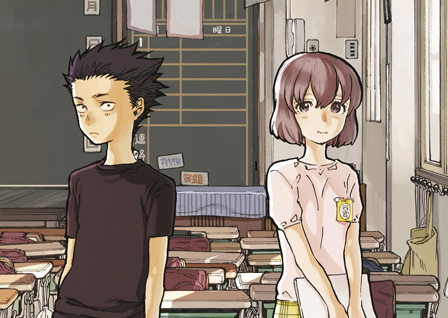
A Silent Voice
by Yoshitoki Oima (translated by Steven LeCroy, lettered by Steven LeCroy)
7 vols
Published by Kodansha
ISBN: 163236056X (Amazon)
SPOILERS FOR THE INTRODUCTION OF A SILENT VOICE (though i don't think it should matter, really):
A Silent Voice begins with the story of two kids in elementary school—Shoya the reckless, popular kid and Nishimiya the new girl, who is deaf and communicates through writing in a notebook (since nobody knows sign language). Nishimiya’s inability to hear and the problems that crop up as a result are too strange for Shoya and so, leading by example, he creates an environment in which Nishimiya is bullied daily and with extreme prejudice. She is scorned, mocked, and has her hearing aids repeatedly torn from her ears and destroyed. When it eventually becomes too much, the girl’s mother complains and all blame is pushed onto Shoya’s shoulders. From that point forward, he is systematically bullied by his former friends in a manner far more buy ventolin online vicious than that with which he instigated against Nishimiya. His resentment against her swells, and he gets into a fistfight with the girl, prompting her mother to remove her from the school. Six years pass and Shoya endures trouble all through elementary school and junior high. Through hindsight and reflection, he finds himself reevaluating those early days, and now as a highschooler, Shoya seeks to have one final, repentant conversation with Nishimiya before removing himself from the world.
And the story moves on from there.
A Silent Voice is concerned with the transition from sociopathy (non-clinical) to empathy. Just as I had to evolve from my early-twenties experience of passive aggression, so does Shoya seek to learn how to melt from his seclusion and inability to relate to others. While the details of his path are different from my own, it’s comforting to see the generalities are not unique to myself. I don’t usually look for representations of myself in the literature I take in, but for whatever reason I appreciate it in this case. Perhaps because I believe that Shoya’s story will end happily, it provokes hope for the conclusion to my own story.
Also, the film adaptation is amazing.
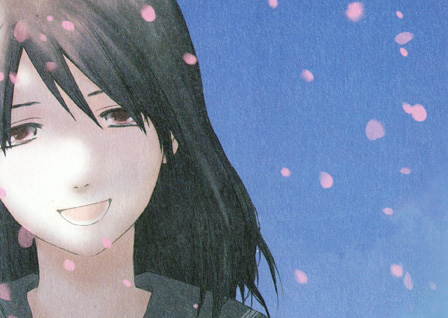
5 Centimeters Per Second
by Yukiko Seike adapting Makoto Shinkai (translated by Melissa Tanaka)
566 pages
Published by Vertical
ISBN: 1932234969 (Amazon)
tl;dr - if you're interested in graphic novel love stories, this is the place to start. also tl;dr - this is for me the gold standard for what adaptation can be.
When I saw that Vertical had released an adaptation of the film, I was initially skeptical. Beyond the fact that adaptations from other mediums into comics rarely fair that well, any adaptation of Shinkai’s film would have to navigate his reliance upon scene-to-scene and aspect-to-aspect cut. Part of the power of Shinkai’s film comes from its staccato barrage of imagery, something impossible to adequately simulate in comics. And then, lastly, I wasn’t sure I was in the mood to watch people engage in romantic suffering.
I needn’t have been concerned. Yukiko Seike’s adaptation acquits itself on all points. More than acquits itself, actually. Because as good as Shinkai’s 5 Centimeters is (and it is good), Seike’s 5 Centimeters is better.
In truth, while sharing a foundation, the two are very different literary artifacts. Kind of like comparing James Fenimore Cooper’s Last of the Mohicans with Michael Mann’s. Seike takes Shinkai’s rather terse script and expands on it… expansively. Her sense for a story that either was only hinted at in the source or even didn’t exist at all is robust. Characters get backstories. Relationships develop. Takaki’s girlfriend has enough dialogue to make the dissolution of their relationship mean something—and we actually bear witness to that dissolution. And where Shinkai’s original ends in three acts, Seike’s creates an entire additional fourth act, moving Shinkai’s world well beyond it’s original purpose.
With all of her additions, Seike’s adaptation strikes an entirely different vibe and its tonal difference is dramatic. Seike’s version is the more mature work and its length and heavy use of dialogue allow it to explore the implications of Shinkai’s world a bit more insightfully.

Lone Wolf & Cub
by Kazuo Koike and Goseki Kojima (translated by )
12 vols
Published by Dark Horse
ISBN: 1616551348 (Amazon)
Back in, what, 1987? I picked up the first two issues of the American release of Lone Wolf & Cub because the guy from the Wolverine miniseries did the cover and recommended it. (That was Frank Miller FWIW.) I was excited by the violence. People had their hands chopped off in panel. It was wild. Nothing like our tepid marvel and DC comics—though I was still blown away by Dove blowing up in Crisis On Infinite Earths. Still, a little bit of gratuitous violence wasn't enough to keep me invested and I abandoned the series after two issues.
It took me years to come back. The stories still feel pretty light to me, but what captures me is the art and the way it conveys mood and ethos. Kojima paints these gorgeous panels and the way he uses light and dark is just lovely. Even if it's just to thumb through, I highly recommend picking up one of these vols (it's only a shame that Dark Horse prints them in such small editions).

Full Metal Alchemist
by Hiromu Arakawa
27 vols
Published by Viz
ISBN: 1421541955 (Amazon)
Fun and rousing for almost the entirety of its duration, FMA makes for an easy read to devour across a handfull of sittings (or in bed after a hernia surgery for me). Tight art and solid plots follow this one through to its conclusion. Its only demerit for me would be a big plus for a good number of readers: the finale had too much action :)
1–1011–2021–3031–4041–50
51–6061–7071–8081–9091–100
101-200201-300301-500Afterword
Good Ok Bad features reviews of comics, graphic novels, manga, et cetera using a rare and auspicious three-star rating system. Point systems are notoriously fiddly, so here it's been pared down to three simple possibilities:
3 Stars = Good
2 Stars = Ok
1 Star = Bad
I am Seth T. Hahne and these are my reviews.
Review copy submission may be facilitated via the Contact page.
Browse Reviews By
Other Features
- Popular Sections:
- Top 100
- Top 75 by Female Creators
- Kids Recommendations
- Daily Recommendations
- What I Read: A Reading Log
- Best Books of the Year:
- Top 75 of 2017
- Top 75 of 2016
- Top 75 of 2015
- Top 75 of 2014
- Top 35 of 2013
- Top 25 of 2012
- Top 10 of 2011
- Other Features:
- Why I ❤ Zita the Spacegirl
- 31 Days of Comics
- Bookclub Study Guides
- Sitemap
























































































































































































































































































































































































































